As I walked around the campus: notes from an outside observer
Navigator Campus personally does not occupy absolutely any place in my life. I do not work there, I have no interests other than idle ones, and indeed, in addition to the times described, I have never been in this building and I know people hats.
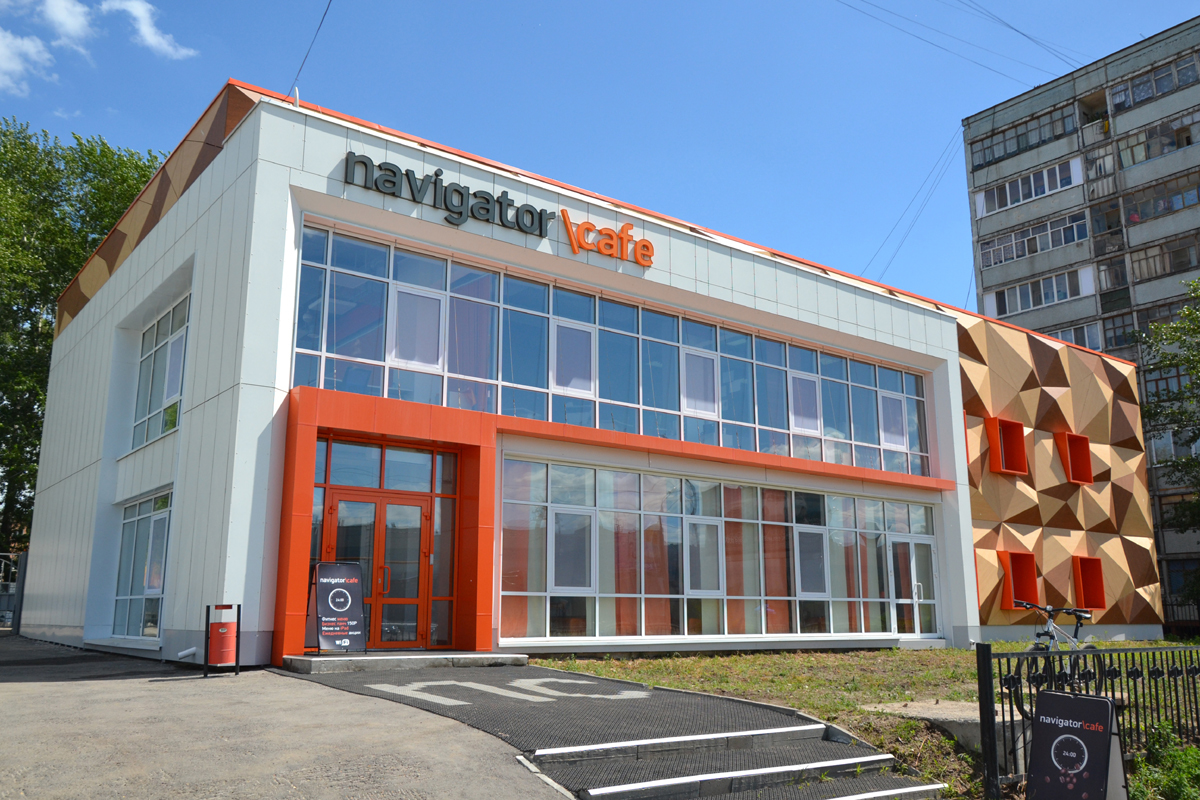
I am a journalist in my direct profession. Moreover, not the usual one who writes about everything in the world with the appearance of a professional in non-capital cities, but a highly specialized, automotive.
The only person with whom I have a personal relationship in the Campus is Vasil Zakiev. We crossed paths with him on a number of third-party projects, and he agreed to give me a tour of the building. Why did I go there? Two reasons. First, there is a steady informational noise around the project in Tatarstan, people skip this topic now and then, and I sit there and apart from lengthy remarks like “well done guys” or “cool, wanted and done,” I can’t add anything substantial. The second, which is a sin to hide, is Vasil’s personal invitation. And I wanted to break away from a very monotonous main work for half a day. You know, when you break somewhere and devote yourself to something new, the return to the ordinary routine is somehow softer and more spiritual. Especially if I studied under the microscope the fruits of someone else's activity. I don’t know, maybe personal pens drove through ...

On the day of the excursion, I was somehow unwell in the morning, I did not have breakfast, and Matiz threw me out according to the standard scheme, on which I now move in anticipation of a new car. I had to go through the whole city, for those who were not in Kazan, I note that the procedure is not so long as unpredictable, and for this reason unpleasant. However, it worked out, drove the tyutelk into the tyutelk. There’s even time to buy batteries for the recorder. Priborchik carry with me mainly for the sake of view. At the sight of a recording device, people often get in shape and engage in dialogue more responsibly. However, on trips in which small details are important (like this one), the practical use of the recorder is also present.
Raced
In appearance, the Navigator Campus does not resemble anything. You can give a stupid comparison with some films about the silicone valley, but objectively, I did not see anything like this in design and execution. I was not able to remove the two-story building from the side in the first minutes - the view was lubricated by a GAZ 3307 with a hydraulic lift, the service organization was cleaning the facade.
I go inside, call Vasily, the excursion has begun ... Initially, I intended not to write anything or even take it off - later stupidly transfer the impression of feelings I got into my soul onto paper. It didn’t work out, the guide’s drive, full of details, “audio content” took its toll, and I pulled out a voice recorder and a camera. As I understand it, my main task this morning was a rational description of what is inside this unusual institution. My guide said that people coming here from different parts of the country and the world do not know exactly what they will see. Well, let's try to smooth it out somehow. We will create a 3D model of Navigator Campus in your imagination, the main thing is not to be distracted, otherwise the structure will turn out to be incomplete.
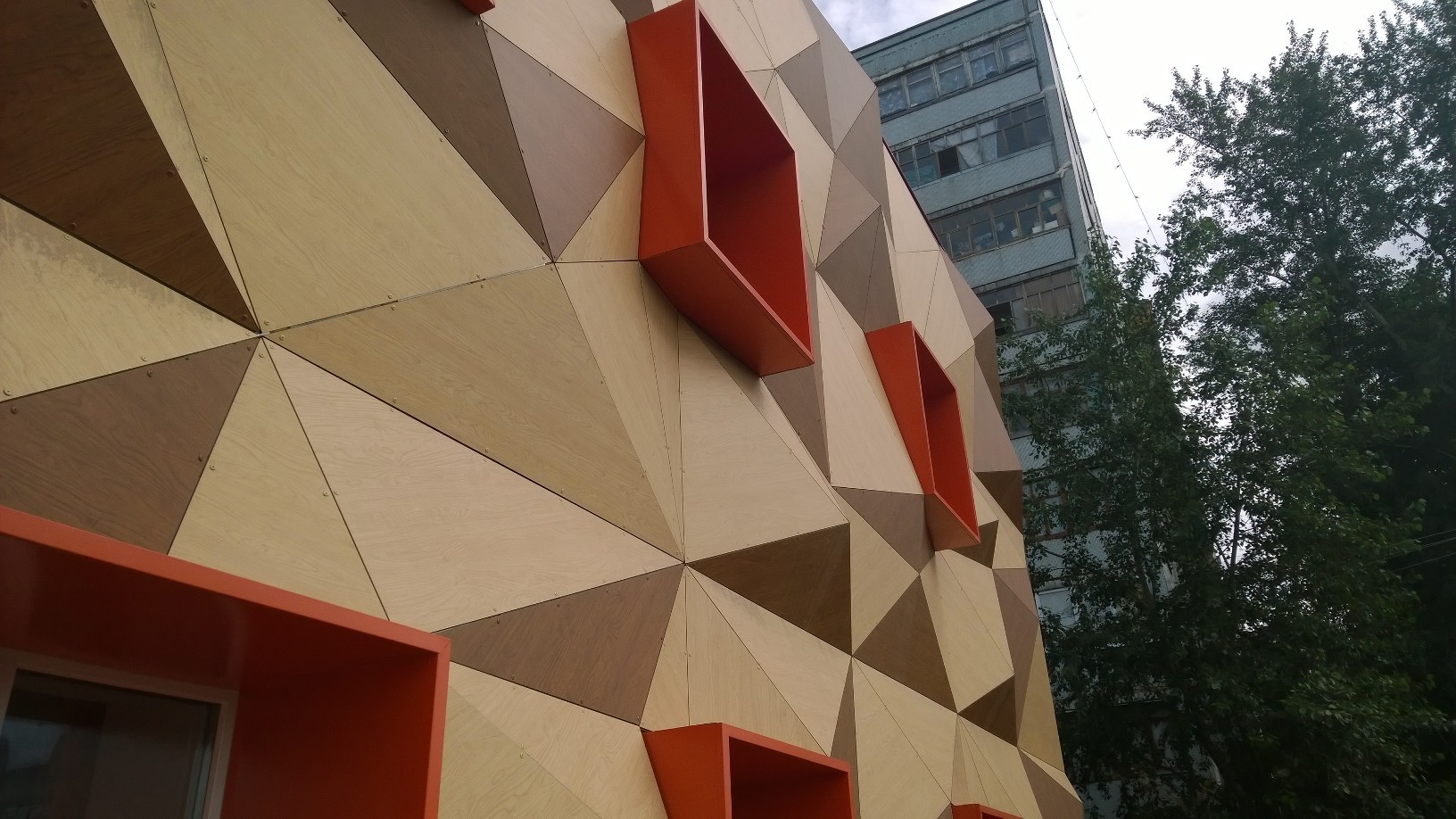
We started exploring the campus from the outside. My companion noticed that the Dutch who took part in the construction of the building, having familiarized themselves with the project, clearly concluded - "wow, wow, crash rashensh." So, as the facade has been technically solved here, a great engineering rarity. It is ventilated, but at the same time it protects the power structure of the structure from moisture and from overcooling. All pieces of the facade puzzle were verified to the millimeter. Only in this situation would the idea really play.
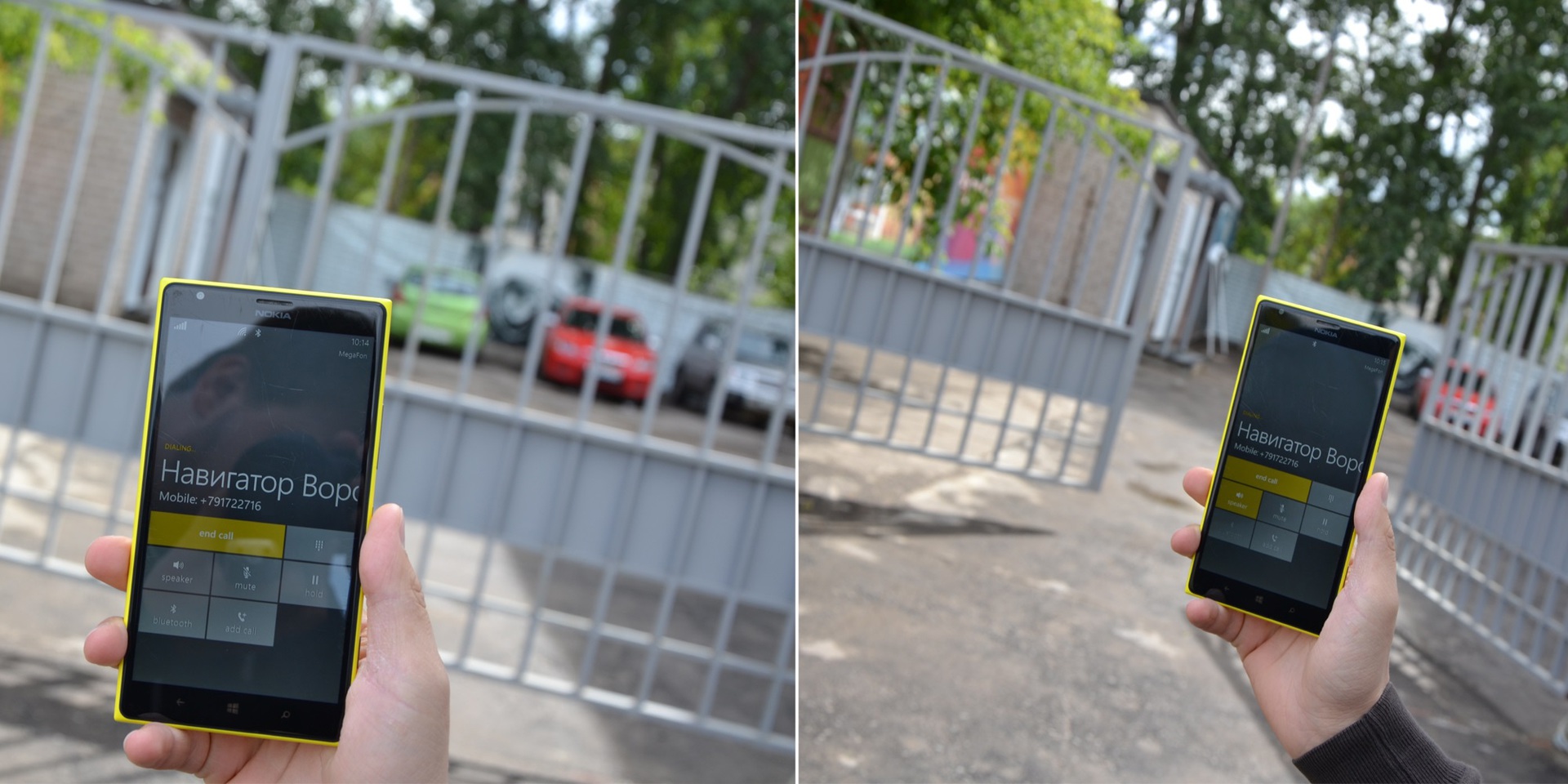
We reach the gate leading to the courtyard of the Campus. Go further quickly failed. It turned out that at this stage, innovative things were involved. The internal development of the guys - the gate leaves obey the electronic system. It works like this - a person calls a special number for the gate, and if he is included in the white list, the gate opens. Everything is simple on the one hand, and very convenient on the other. No ciphers and electromagnetic locks. I dialed the number, the gate opened. Setting up an access sheet is also very simple. New motorists can be added to Google sheets without delay, as well as to exclude the former. In fact, a trifle, but from such trifles it develops ...
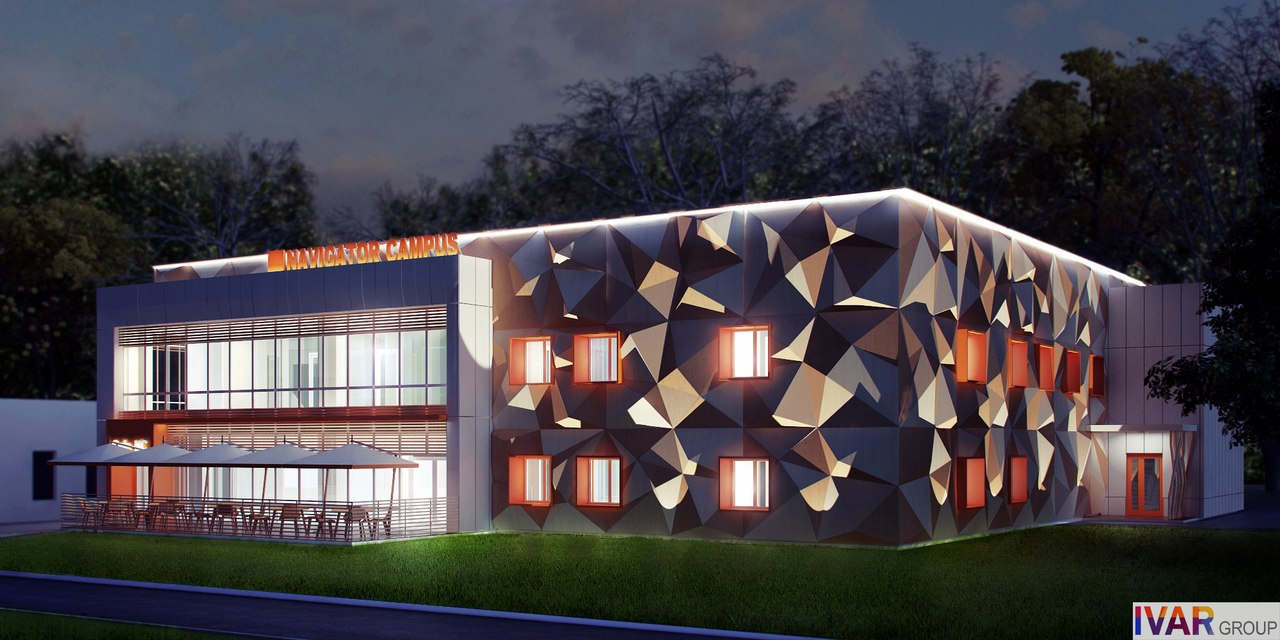
A reader who has not been to Kazan may suggest that such an unusual project as Navigator Campus is located in the very center of the city near the Kremlin and other historical buildings. And no! It is located in a residential area, which is popularly known as the "Quarter" or "Quarter". The Kremlin is about 5-6 kilometers from here, and then through bridges and interchanges. The trick is that nearby there are free parking lots, a huge hypermarket, a cinema, a fitness center and a bunch of other socially important objects. In addition, most of the people who work here live nearby. And those who come do it in opposition to traffic jams - when the whole city from the outskirts goes to the center, workers from the center go to the sleeping area and vice versa. And one more important aspect. Initially, the project was sharpened by bicycle workers.

The internal platform is a parking, an airfield, a cosmodrome and a training ground in one bottle. There are not many cars here - once again I draw the reader’s attention to the fact that basically simple young people work here, who do not have so many cars (may God forgive me, but maybe this is for the better).
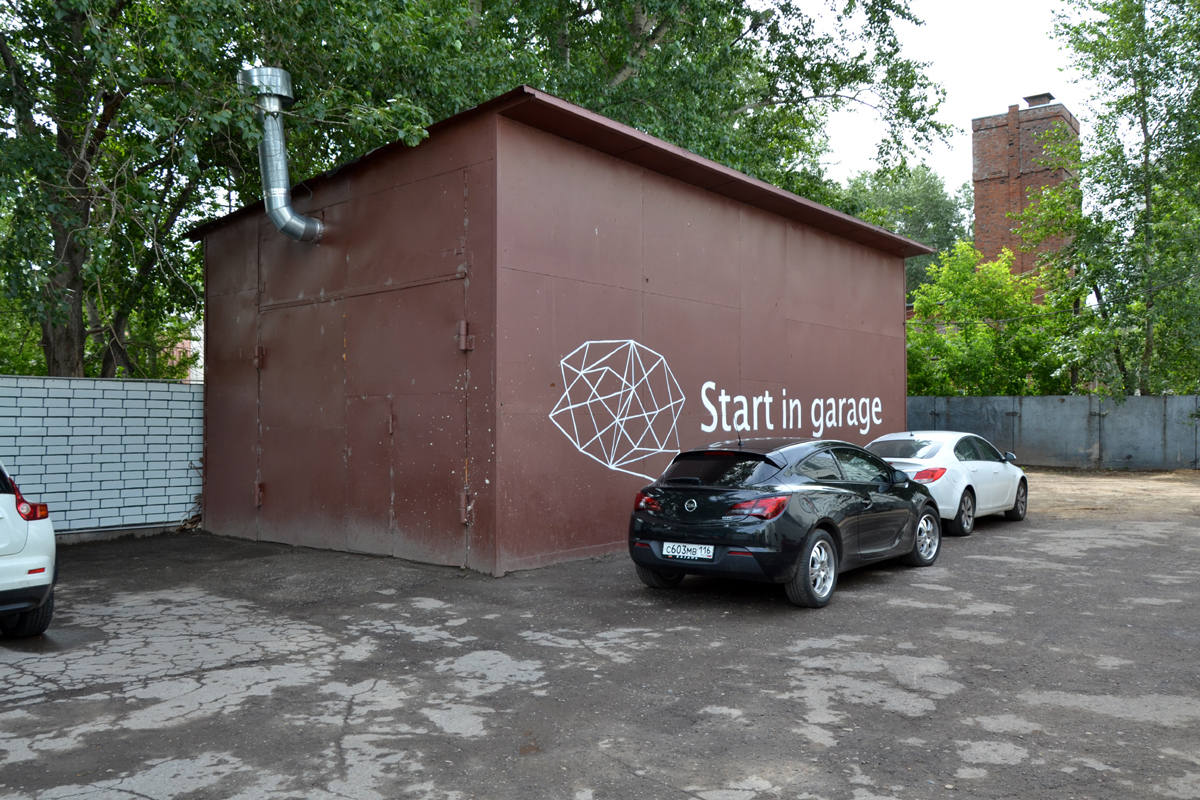
Since the building is tightly blended into the surrounding landscape of tired high-rise buildings in the sleeping area, the locals first tried to include some kind of opposition to the construction. The guys even had to laugh it off that a quiet and peaceful nursing home would be opened on the site of the former car dealership. Later, when the Campus was put into operation, questions from the locals disappeared. On the contrary, there was some pride in their area. After all, Medvedev came almost to their porches!


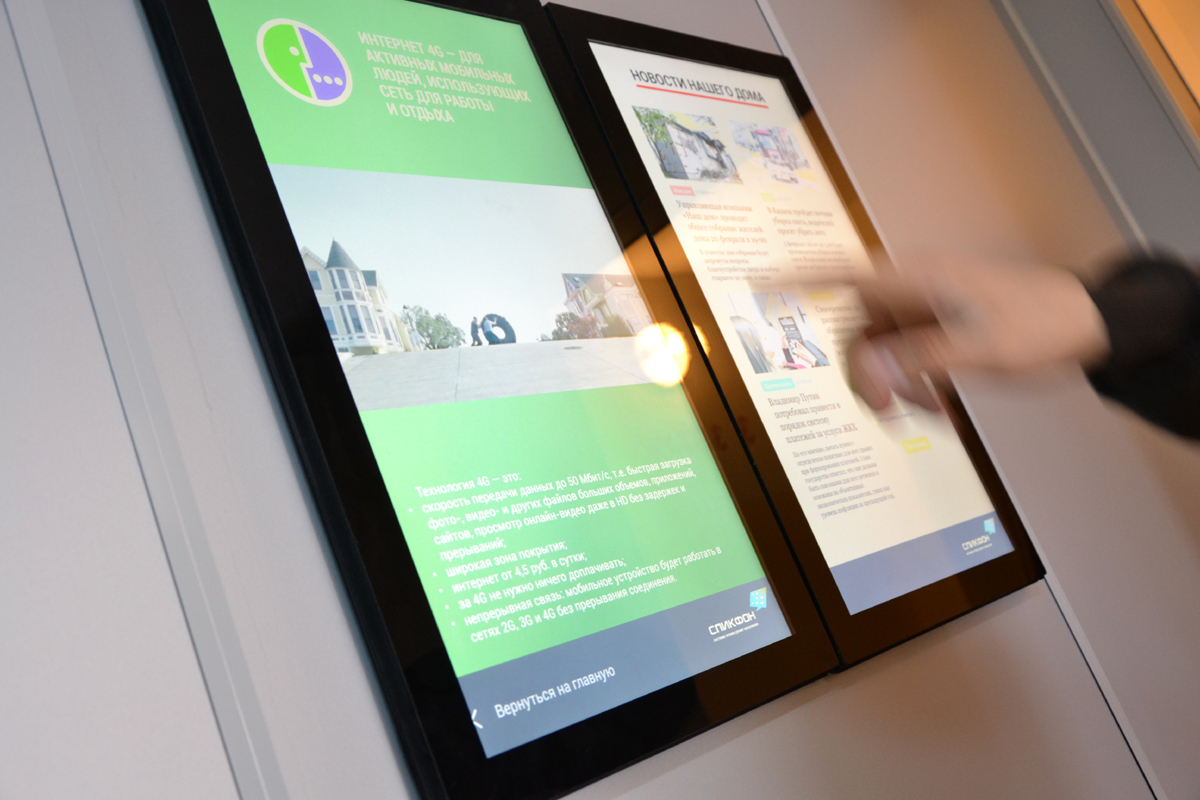
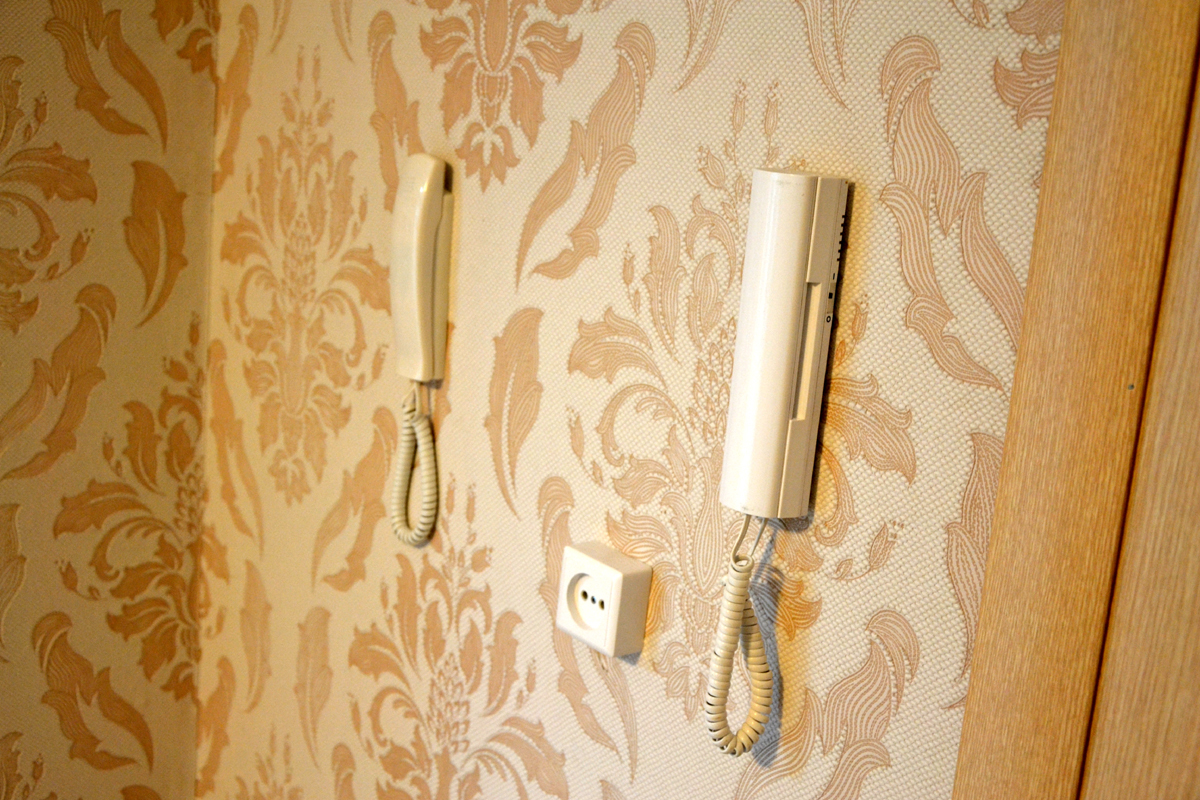
Showroom company "Spikfon". About guys have a separate post on the Habré . In short, on the site near the main building of the Campus there is a model of an ordinary staircase, stuffed with various technical gadgets from advertising and audio information from ZheA in the intercom instead of waiting beeps to various complex emergency warning systems or transmitting information from meters directly to information processing centers. There is also an imitation of an elevator with high-tech advertising LCD panels instead of standard paper ones and much more.


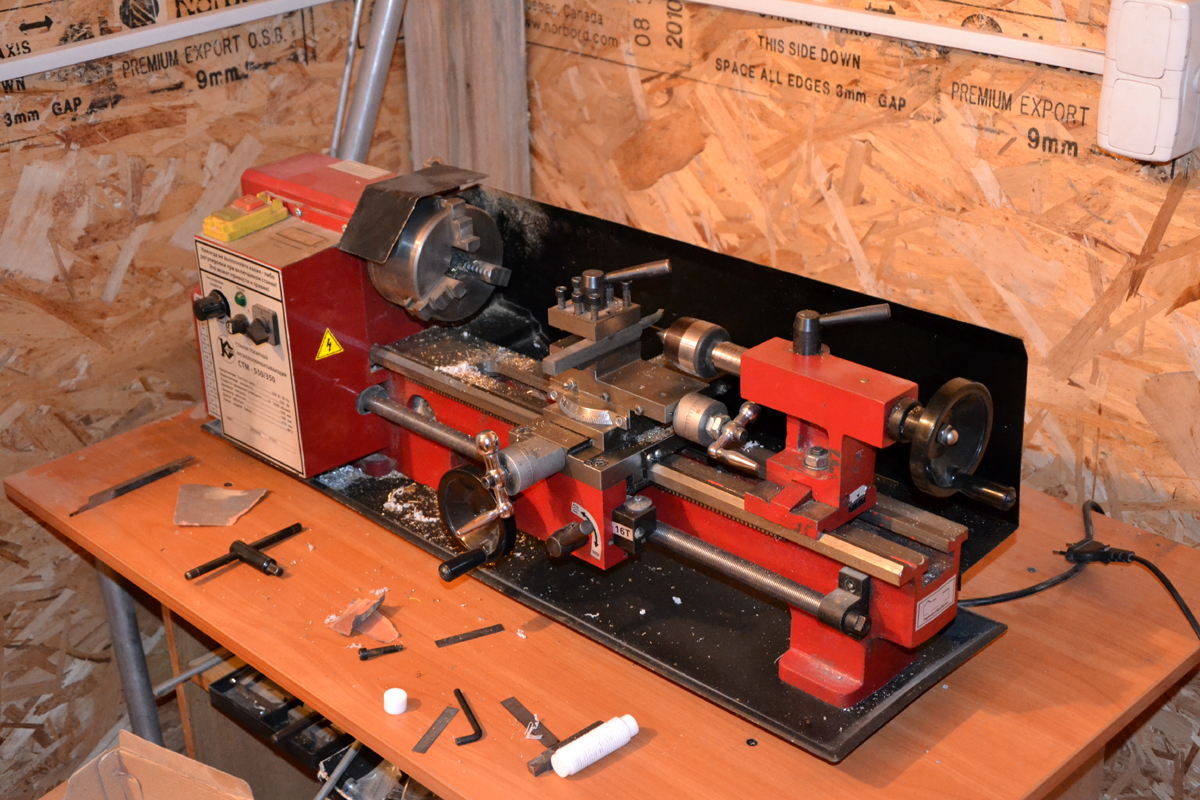
In the courtyard next to the entrance layout is the second and last freestanding structure in the territory, it is a former garage, once a change house, later the first version of the hack space (laboratory), and now there is a place for the most dirty technical manipulations. Here, as in the main laboratory, which we will see later, there is all the necessary tools for engineering work. Moreover, both manual and stationary, including even CNC machines. Currently, the premises are mainly used by the local company “Ennova, which is developing 3D printers . In general, the topic of 3D printing in red thread runs through the entire Campus, but more on that later.

A small metal hangar as a submarine has several compartments and from this inside there is noticeably less space than it seems from the outside. But here it is warm and its arrangement cost much cheaper than the main laboratory. My attendant let out that if he had started building Navigator Campus today, he would have made many of its elements as simplistic as this garage. However, history does not tolerate the subjunctive mood. Yes, and the spare laboratory looks cheerful, but not very aesthetically pleasing.
From the interesting things in the “garage” I was shown several copters - one of which has real chances to turn into a vehicle that can lift two adult men into the air. Only nobody has said a word about this, as well as about the space ambitions of the Kazan project Navigator Campus, aloud. There are really enough secrets here, the phrase “do not write about it yet” is just a local motto!

We move on, I’ll try to speed up the pace of the story. The most well-known this feeling when you read a rather interesting, but long text. The lyrics are further to a minimum.

We go into the building. Two floors, 120 jobs for talented youth, of which about 90 are already really occupied by thinking people who are realizing their ideas here. The area of the first stage is 1,200 square meters. There are plans to expand it. On the ground floor there is a cafe-bar-coffee shop. And not just a cafe, but a very decent establishment with professional equipment and highly trained staff. Here everything is from and to GOST, so to speak, there is even a separate egg shop, which generally should be in any food service establishment, but in reality it’s rare. Surprisingly, even in the cafe the guys managed to create. Based on local cuisine, an internal startup Food Cult.. The trick is that now, in addition to the usual rolls and pizza right on the campus, you can order a real set of products for preparing a restaurant dish. For relatively little money, they will bring you home instructions and the necessary set of already washed and chopped ingredients for preparing a unique dish at home. Everything is 100% fresh and balanced - no chemistry ...
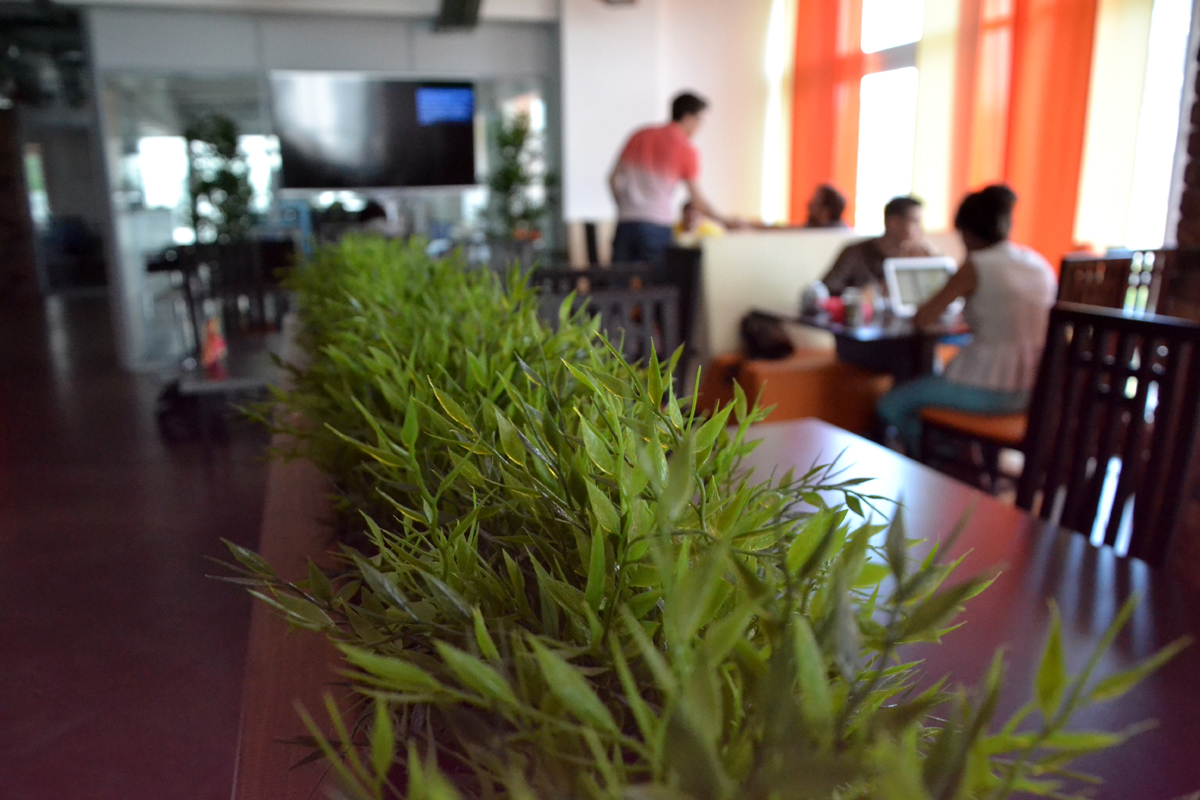


In addition to the 90 occupied jobs described above in the Campus, informal jobs at café tables are also actively used. This is facilitated by fast free wi-fi and sockets near each table (!) As an unloading of brains here is the Xbox. This cafe, by the way, is not like any other cafe among those that I have been to. The feeling of reality is lost - as if he had gone home to some geek.
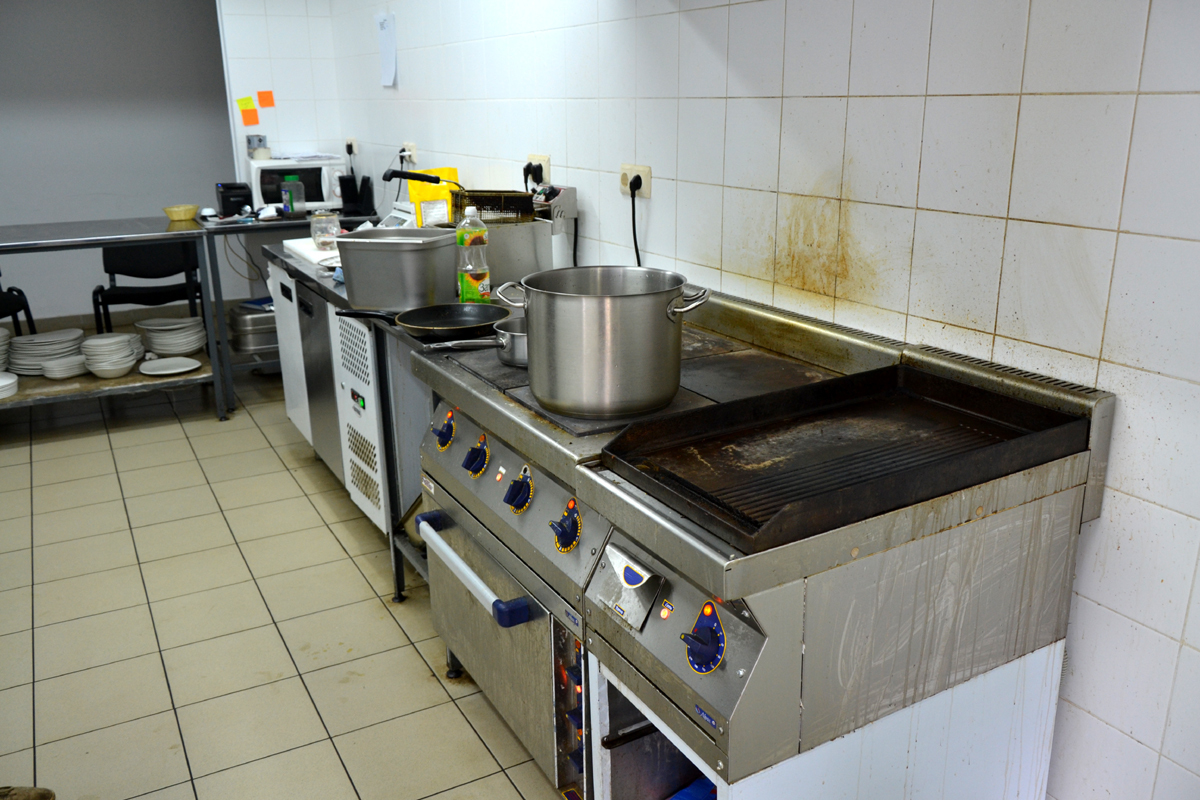

Access to various blocks of the building is carried out by electromagnetic cards. Now, however, this will not surprise anyone, but adds charm. In general, the place feels somewhat reminiscent of the laboratories from the first Half-Life.


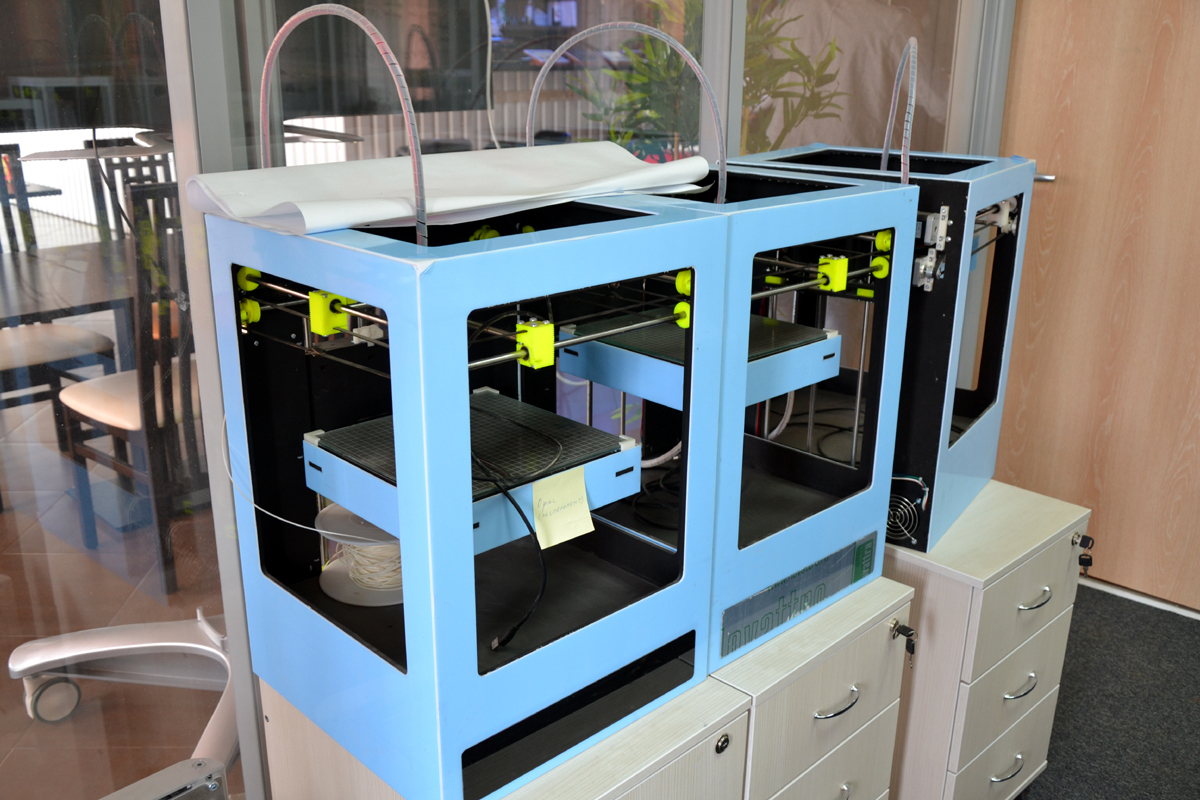
The standard office (here are just the guys from Enna who I already started talking about earlier) consists of several petal tables. Specifically, here (pictured) are six people. And as usual, you can watch 3D printers everywhere. For me, as an uninitiated person, they are, of course, very similar, but Vasil insists that several generations have passed since their first appearance. Relatively fresh are printed with photopolymer and are not heated. The idea was not difficult to understand: the projector illuminates the photopolymer layer by layer, fixing the material in the desired shape. Almost everything that is in this office is at the prototype stage and will be finalized.
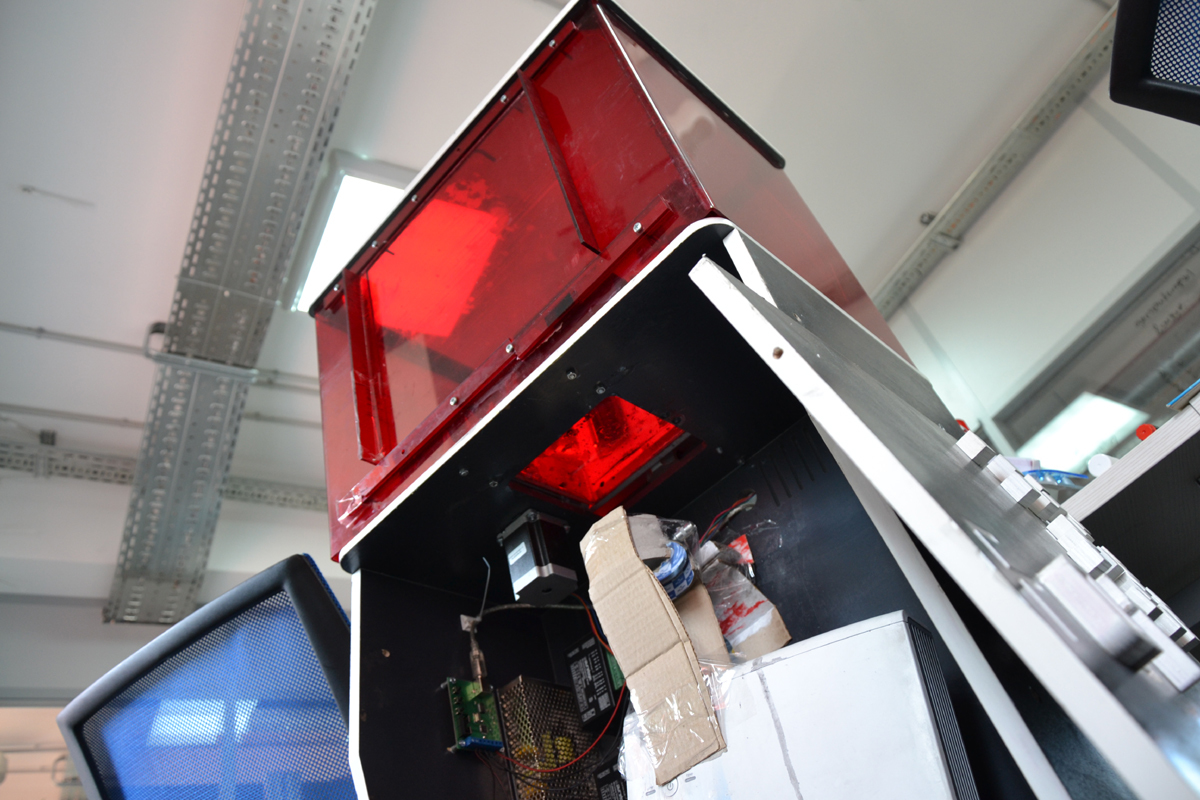

In general, the creators of Navigator Campus really believe in 3D printers and seriously compare them with the first personal computers, which later sold around the world in billions of copies and became an integral element of modernity. There is probably some truth in this. The very idea that anything you can print in a few minutes is fascinating. Yes, and this is logical in an accelerating fashion.
To my question - “are you not afraid that the same thing will happen with printers as with airships”, the guys answer, smiling - “life is long, there are 3-4 attempts and there is a big chance of success in at least one of them”.
Now in “Navigator” on 3D-machines do anything. From cases for iPhones according to drawings created by myself to mugs. One of the local engineers told me the bike that, having forgotten the mug at home, he printed it for himself in a few minutes on a printer. To my natural question about the hygiene of such an act, the engineer assured me that the plastics used are supplied from the EU and have all possible quality certificates.
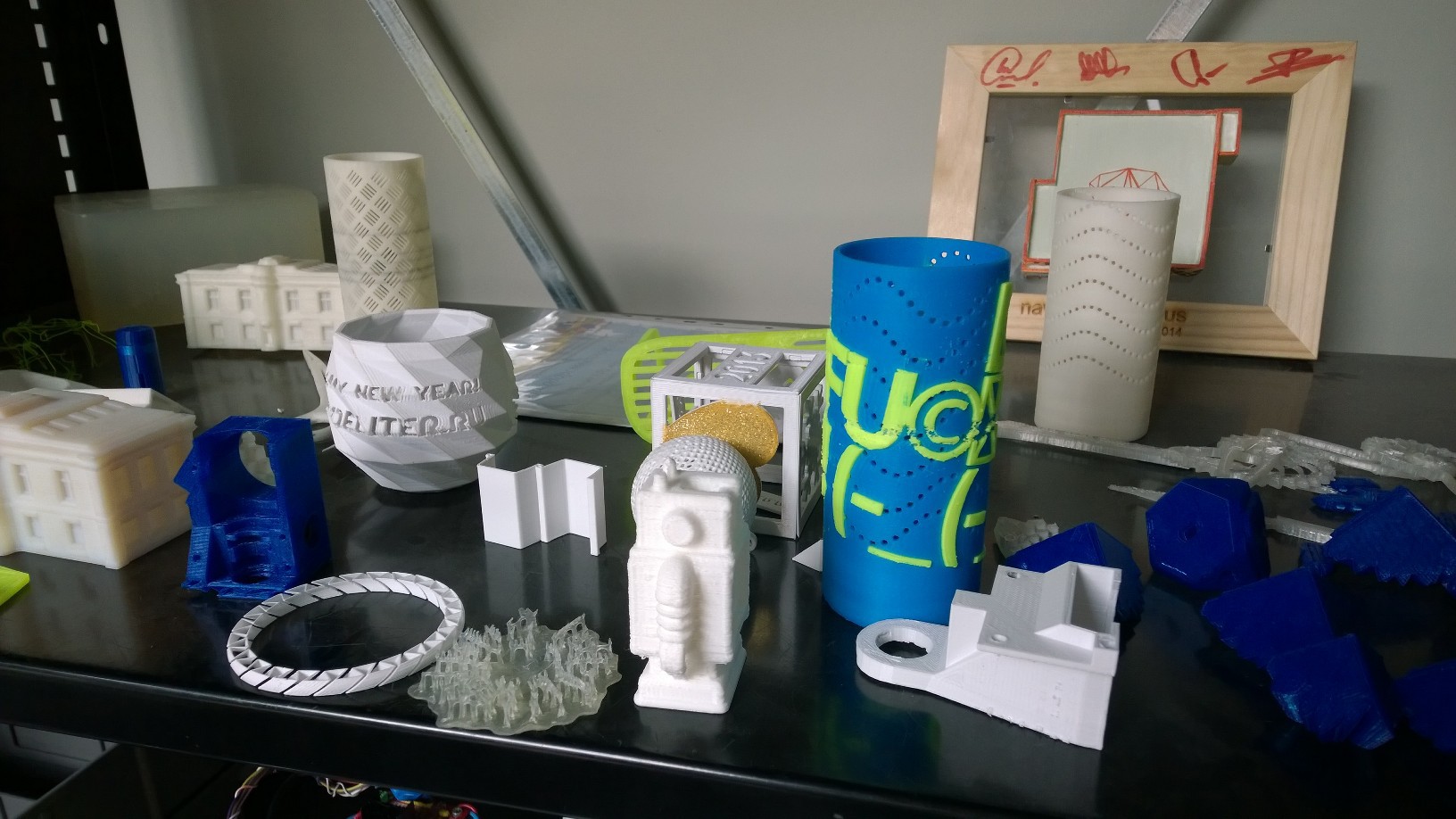
The most important use of equipment that prints reality is classical engineering. To hold in your hands a complex part of a car or aircraft, for the designer it is priceless. I know for myself - my father is an old-school aircraft engineer and even he, who has 50 years of experience, sometimes lacks these new technologies. It is necessary to include all possible and impossible spatial thinking in order to imagine any complex part, set in a tricky place with unique kinematics. And then I printed it out cheaply and quickly, applied it, thought it over and quickly understood in which direction to move on - cool, not the right word!

Moving on - meeting rooms. There are several of them in the Campus and they are all named after the Tatar national writers. I was always wary of these cultural figures, but after reading “Shurale” by Gabdula Tukay in a Russian translation (I repent), I changed my mind once and for all. Bribed not even the idea of a story about the devil, but the beauty and imagery of the syllable. Again distracted, move on.
Since the "meeting rooms", in fact, are located in the epicenter of the laboratory, in which they constantly compare, saw and cut something, the meeting rooms here are equipped with soundproof doors. I did not believe, I thought about making fun of me, and asked to close me in one of these halls. Quiet, very quiet, like in a movie about boxers, when the main character receives a knockout blow.

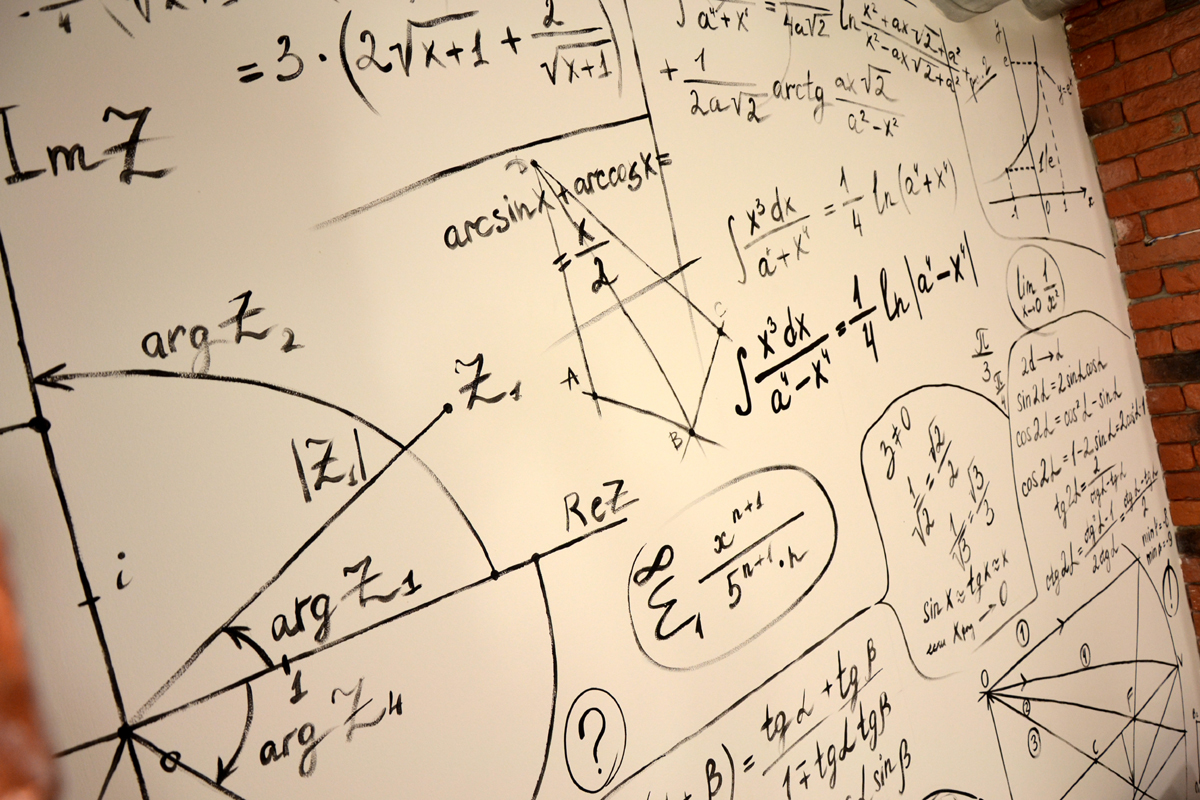


I’ll add a few words about the service premises. He specifically insisted that I open all the locks and show me, so to speak, "from below." Nothing bad can be said. Everything is clear: toilets, showers, and server rooms. The guide, by the way, was not particularly embarrassed, and he had enough competencies to tell even about such nuances. The server system is designed to dispatch a building with a large margin. The Internet was carried out with the use of not cheap equipment that has little in common with household systems, reserved large electrical capacities behind the building, again, taking into account future expansion.

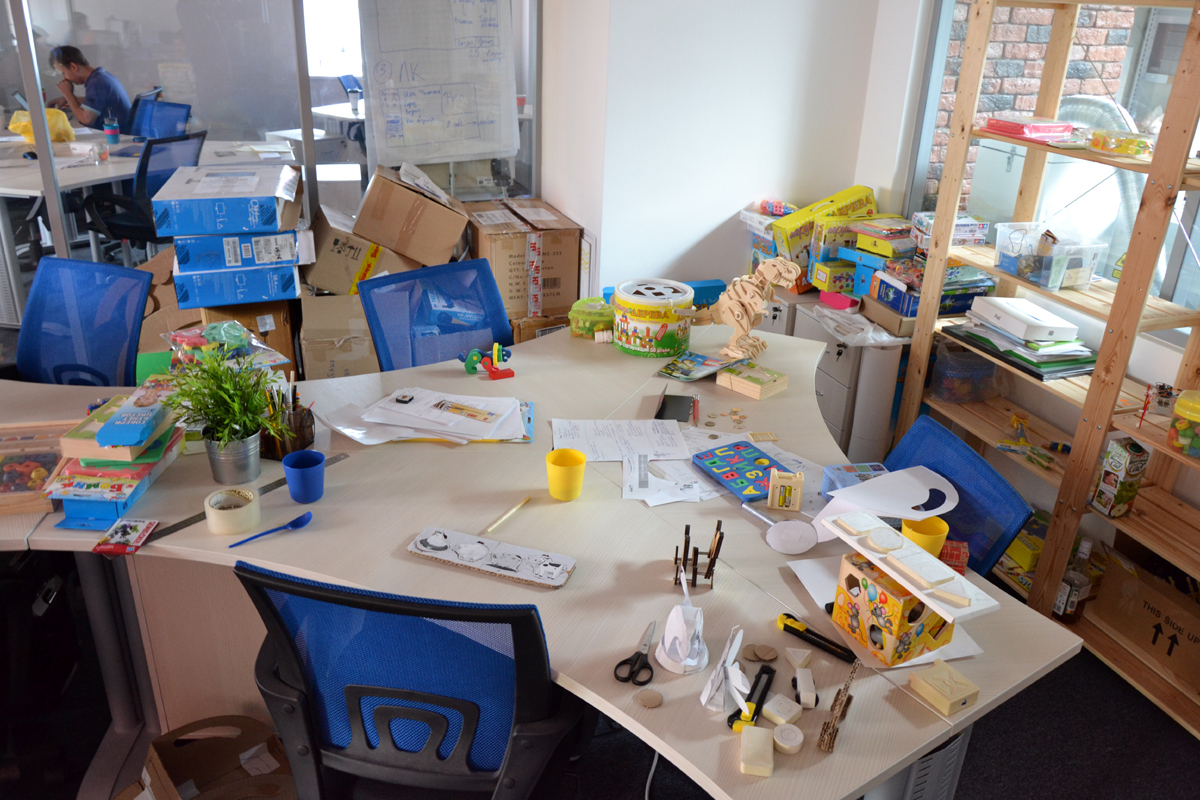

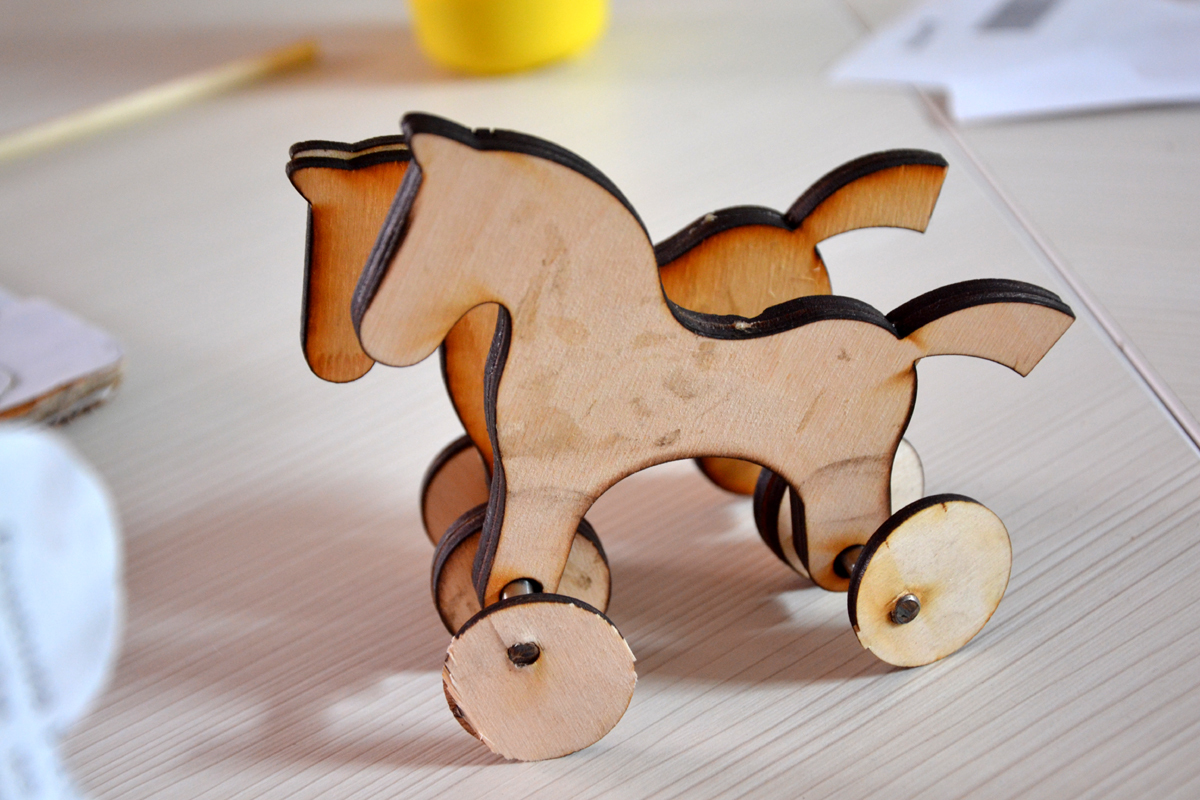
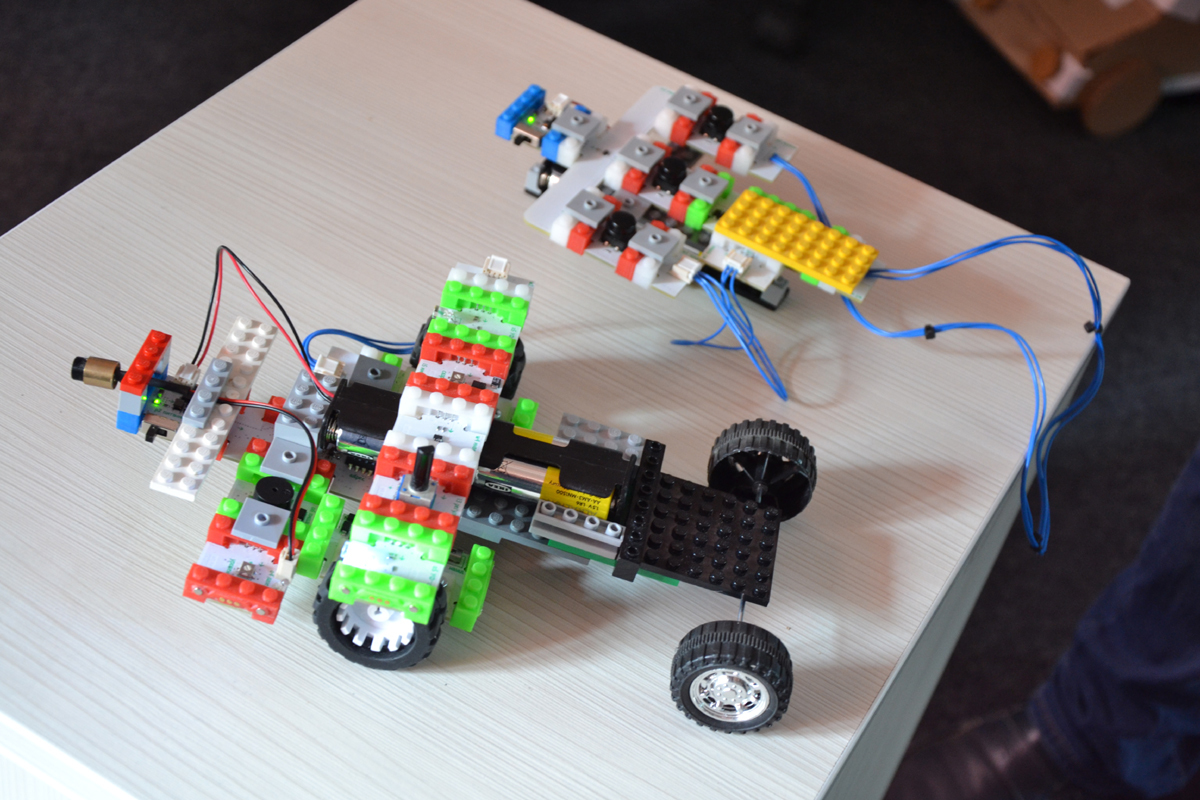
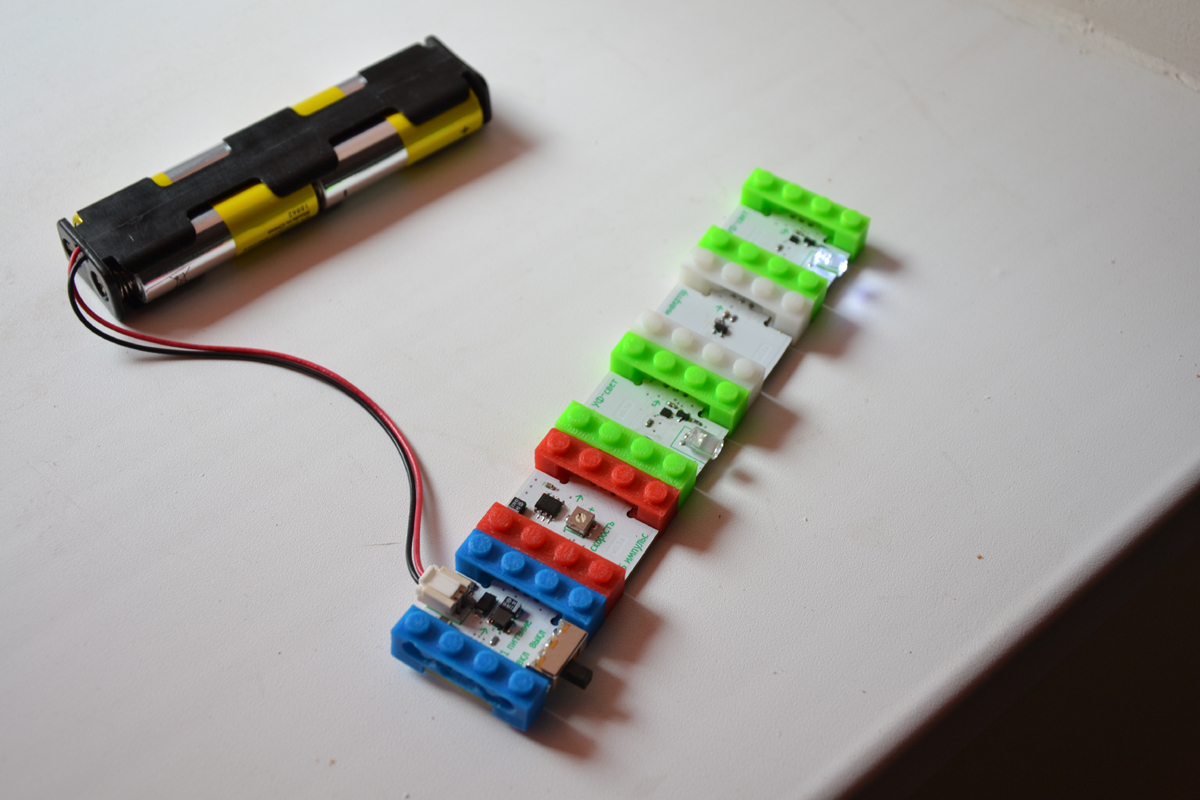


We move smoothly to the second floor. There are people involved in various innovative developments. For example, the guys from the company Marabaka are specialized in the production of toys. The most interesting product is the modular electronic designer “ Microparticles ”." To explain the principle of its work is much more difficult than to actually play with it. If mega reasoning is simplified, then we have batteries (batteries), controls (buttons, twists, sensors, motion sensors, sound sensors, light sensors and toggle switches) and various peripheral devices (bulbs, speakers, electric motors, etc.). All this is connected in random order into chains, based on the power of your imagination. You can complicate the game ad infinitum. Options wagon and large trolley. There are, by the way, control chips. In essence, this is still hardware programming. Everything is elementary and very exciting. By the way, using the same 3D printers, the power of this designer can be combined with the architecture of any third-party designer.

To top it off, the developer thinks about the “open source” scheme, in which third-party manufacturers will be able to release modules to the designer. I, like a big child, got hooked.
The Micropart Designer for Marabaki is the main product. In addition, the company is engaged in the development of any toys to order. And again, 3D printers come in handy here as well as possible, since in a nearby laboratory you can get a live prototype from any material in a few minutes, while evaluating its pros and cons.
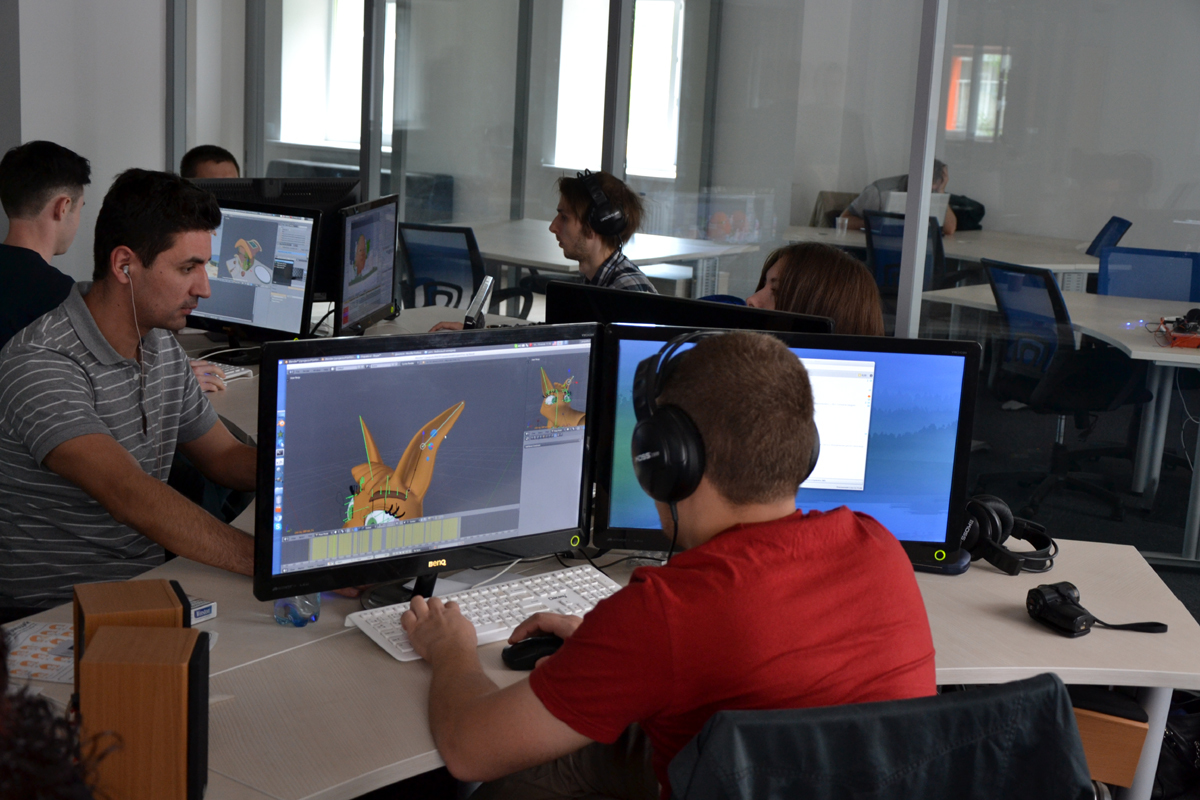
The next stop is the office of the Campus-based company engaged in 3D animation modeling. In fact, the guys are extremely intelligent and can make cartoons literally from A to Z. Already now, the fruits of their work can be enjoyed on the main TV channel of the country as part of the program "Good night, kids." Moreover, the head of the 3D studio conducts specialized courses on the Internet - http://vk.com/blender_kzn , devoted to the development of the Pixar and Walt Disney affairs in the country. It is planned that over time, the company will grow into an entire animation school-studio in Kazan. In general, they are very fanatical people, so much so that they speak of themselves as fanatics of the craft.

One of the most pressing issues at Propellers is personnel. The office needs specific people - a kind of alloy of technicians and lyricists, iron specialists and at the same time subtle artists imbued with the magic of art. Propellers is now actively recruiting such people and invites partners for cooperation. The company, by the way, is already making money on production, working with large Moscow firms.

Funny moment. Arthur Shamshatdinovand his friends, using the neighborhood with the Campus state-of-the-art laboratory, made a digital Ukulele (Ukulele), a four-stringed plucked musical instrument originally from Modeira Island, as part of a hobby. The main feature of this particular instance is its digital component. A small guitar, which is a wooden block with strings, can be connected to the headphones and play music without distracting colleagues from work. In size, it is slightly larger than the phone, which allows you to take it on trips without any doubt. Well, we are waiting for the first industrial designs.
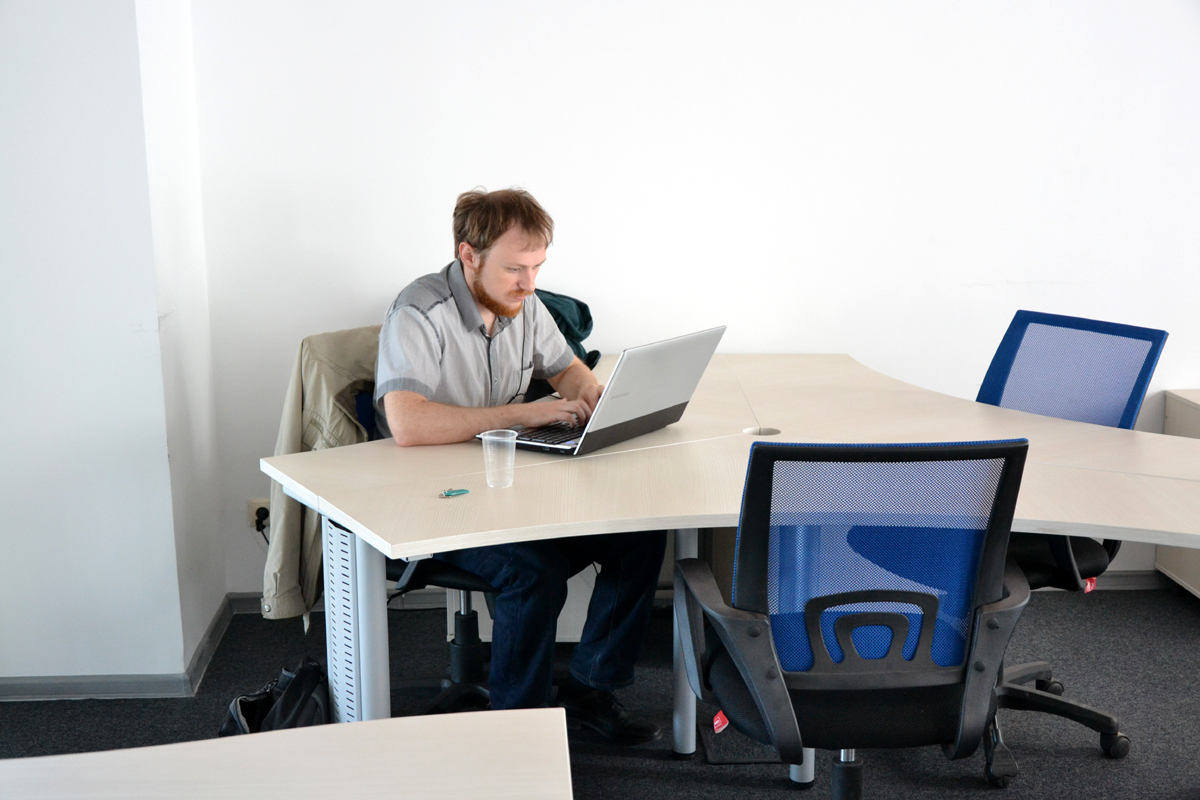

Move on. Vasil prepares me for a meeting with the next employees of the Campus. This time the guys are not from Kazan. The first one we managed to talk to was Anton Nikonorov from the CamIRa project, about which he was alsopost on Habré . In the idea, the device that is being worked on here performs a preventive function, warning industrial workers about emergency situations with their equipment. The principle is again simple, like all ingenious: there is an ordinary optical camera and a thermal imager works in conjunction with it. Comparing the temperature data on the normal functioning of the equipment with the real state of affairs, the electronics recognize overheating and signals the operator. The idea is that in most cases, before a failure, the equipment in some places locally overheats. As a rule, at the initial stages of abnormal operation of the same machines, they can still be returned relatively quickly to service.
The second project, which is also developing in the same office, but at the next table, is called Anky, and about them there was also a post on Habré . Also cool and original. The idea is this - does your flower require a special watering regime and will not withstand both dryness and too moist soil? Then we will come to you: an affordable automatic plant sprinkler for holidays. In addition, soil irrigation programs can be loaded into the electronic brains of this contraption, depending on the delicate “mental constitution” of your flower. Thus, the chance to survive in this complex world with a capricious home flora increases significantly.


Last adventure: hackspace. That around which everything described above revolved. A laboratory stuffed with the latest technology from the latest models of 3D printers, laser cutting machines and PCB manufacturing machines, to antistatic suits and cabinets, stuffed with expensive tools from top to bottom. Only three countries can supply equipment here so far: USA, Germany and Japan. And this applies both to large appliances, and, for example, vacuum cleaners. I was afraid to ask how much it all cost. I did not want to blow my brain. Judging by Vasil’s view, the figure is multi-zero.

The engineer working here, impregnated with the spirit of perhaps the best specialized laboratory in the region, enthusiastically talked about everything that my eyes rested on. According to him, you can make here almost anything your heart desires. And you know, it was believed. It's great when people like this guy meet up with such projects. Here he is like a fish in water, there are no taboos or this exhibition surroundings, when everything is cool, but nothing can be touched. No, no, he touched all this, turned it on and eagerly explained the principles of work.

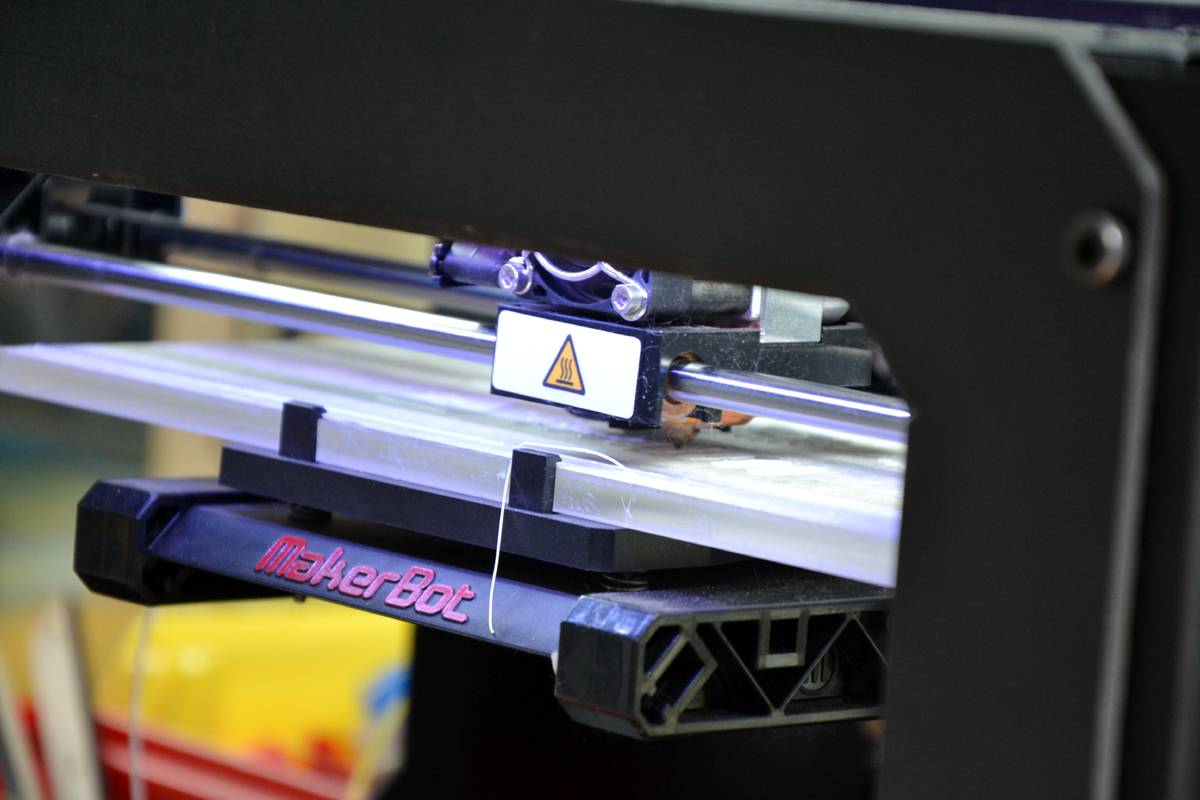


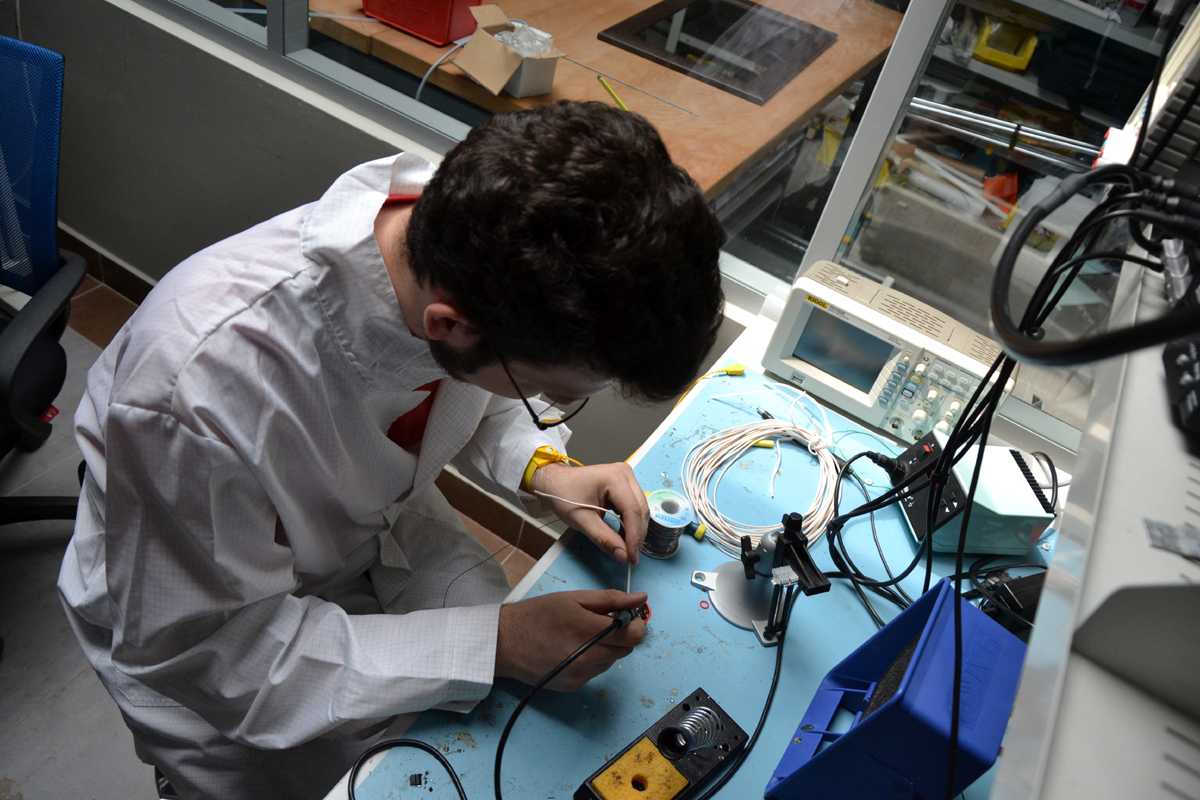




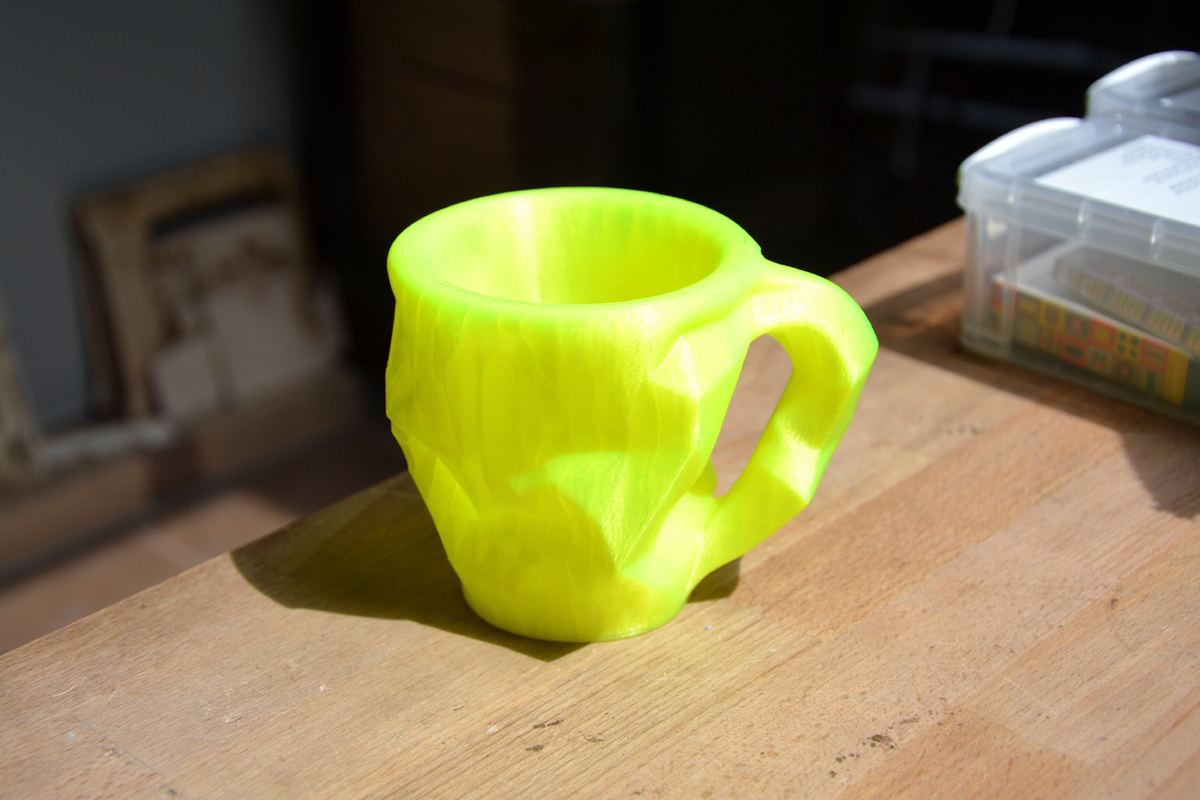


What are the findings? Well, you’ll probably make your own. Moreover, this is not quite my platform and I do not fully understand the specifics of the audience. My conclusions are as follows. When I was a teenager, my parents enrolled me in a technical circle. He was of the Soviet type and was not distinguished by high-class equipment, however, kind people managed to present the world of technology for me, so I fired up for life. And at that moment I did not need anything more than a bulb working from a dynamo or a rusty woodworking machine. The main thing was the direction of movement, which I then went on and, in principle, do not regret.


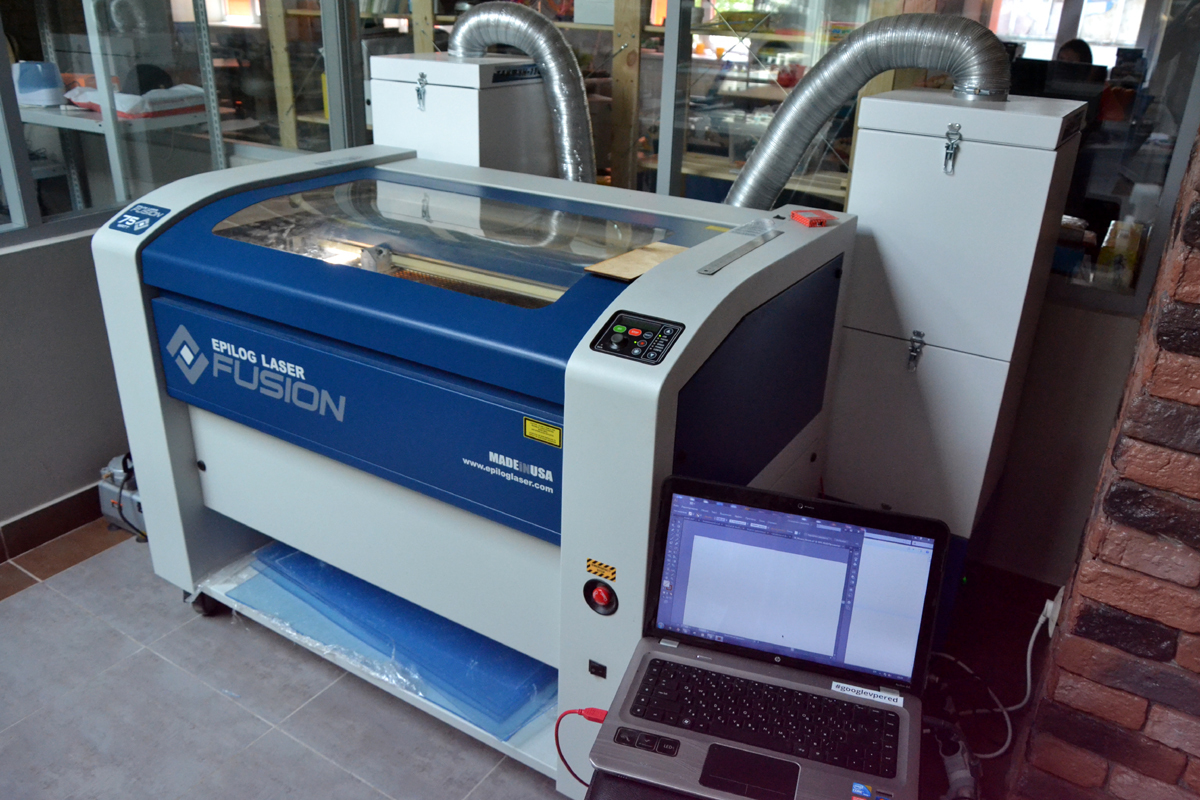
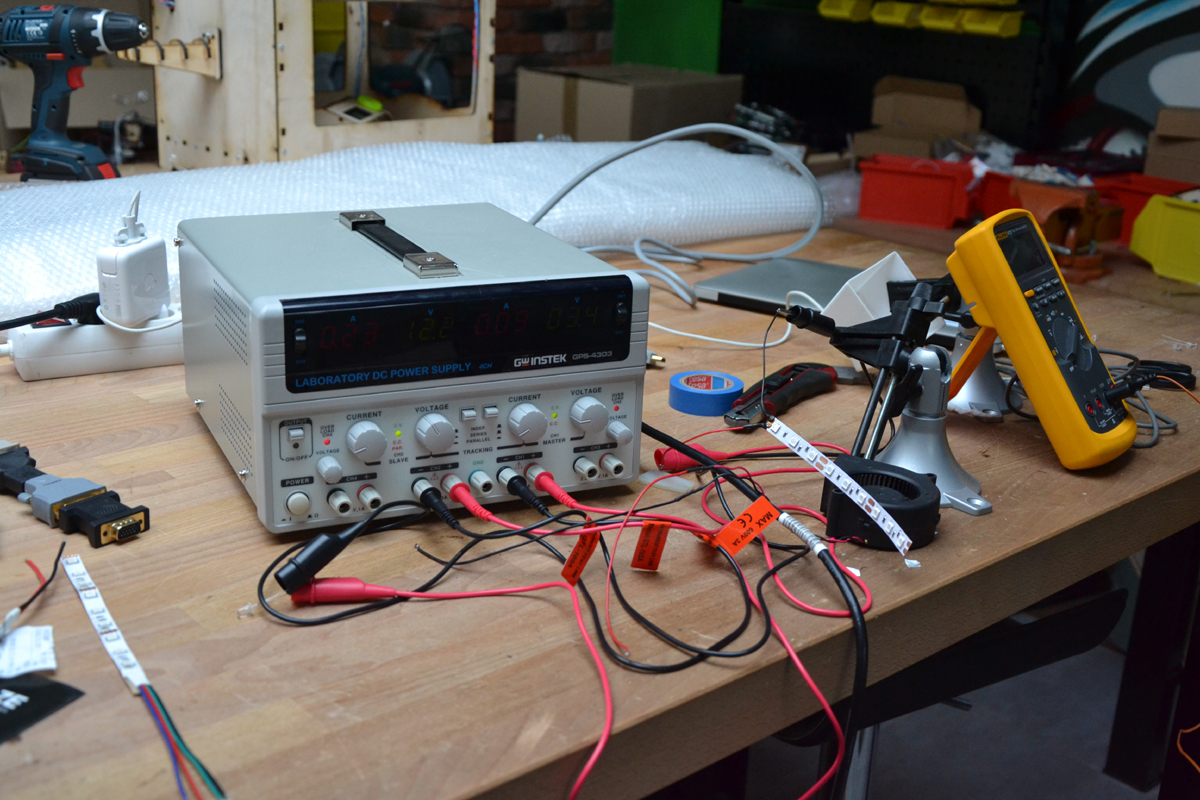
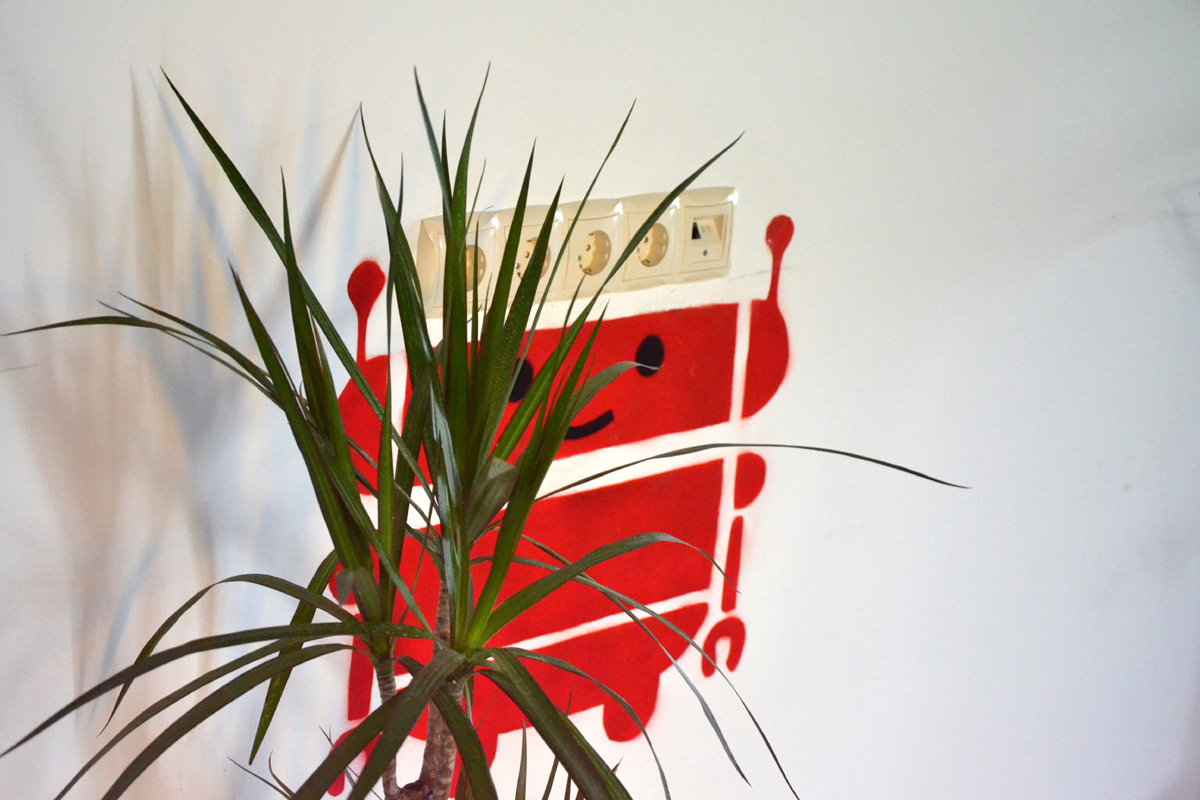
Times have changed, now in honor of information technology. However, a place like Navigator Campus still fulfills this social role of engineering infection of the brains of young people. Along with young startups, schoolchildren often work here and learn a lot for themselves. And again, they don’t need much, the main thing is to overcome the fear of these boxes with wires and not be afraid of breakdowns of expensive equipment. I’m waiting for the time when the Nobel laureate in physics will mention the name of this place in his speech in Stockholm. I'm really waiting ... Honestly ...

I am a journalist in my direct profession. Moreover, not the usual one who writes about everything in the world with the appearance of a professional in non-capital cities, but a highly specialized, automotive.
The only person with whom I have a personal relationship in the Campus is Vasil Zakiev. We crossed paths with him on a number of third-party projects, and he agreed to give me a tour of the building. Why did I go there? Two reasons. First, there is a steady informational noise around the project in Tatarstan, people skip this topic now and then, and I sit there and apart from lengthy remarks like “well done guys” or “cool, wanted and done,” I can’t add anything substantial. The second, which is a sin to hide, is Vasil’s personal invitation. And I wanted to break away from a very monotonous main work for half a day. You know, when you break somewhere and devote yourself to something new, the return to the ordinary routine is somehow softer and more spiritual. Especially if I studied under the microscope the fruits of someone else's activity. I don’t know, maybe personal pens drove through ...

On the day of the excursion, I was somehow unwell in the morning, I did not have breakfast, and Matiz threw me out according to the standard scheme, on which I now move in anticipation of a new car. I had to go through the whole city, for those who were not in Kazan, I note that the procedure is not so long as unpredictable, and for this reason unpleasant. However, it worked out, drove the tyutelk into the tyutelk. There’s even time to buy batteries for the recorder. Priborchik carry with me mainly for the sake of view. At the sight of a recording device, people often get in shape and engage in dialogue more responsibly. However, on trips in which small details are important (like this one), the practical use of the recorder is also present.
Raced
In appearance, the Navigator Campus does not resemble anything. You can give a stupid comparison with some films about the silicone valley, but objectively, I did not see anything like this in design and execution. I was not able to remove the two-story building from the side in the first minutes - the view was lubricated by a GAZ 3307 with a hydraulic lift, the service organization was cleaning the facade.
I go inside, call Vasily, the excursion has begun ... Initially, I intended not to write anything or even take it off - later stupidly transfer the impression of feelings I got into my soul onto paper. It didn’t work out, the guide’s drive, full of details, “audio content” took its toll, and I pulled out a voice recorder and a camera. As I understand it, my main task this morning was a rational description of what is inside this unusual institution. My guide said that people coming here from different parts of the country and the world do not know exactly what they will see. Well, let's try to smooth it out somehow. We will create a 3D model of Navigator Campus in your imagination, the main thing is not to be distracted, otherwise the structure will turn out to be incomplete.

We started exploring the campus from the outside. My companion noticed that the Dutch who took part in the construction of the building, having familiarized themselves with the project, clearly concluded - "wow, wow, crash rashensh." So, as the facade has been technically solved here, a great engineering rarity. It is ventilated, but at the same time it protects the power structure of the structure from moisture and from overcooling. All pieces of the facade puzzle were verified to the millimeter. Only in this situation would the idea really play.

We reach the gate leading to the courtyard of the Campus. Go further quickly failed. It turned out that at this stage, innovative things were involved. The internal development of the guys - the gate leaves obey the electronic system. It works like this - a person calls a special number for the gate, and if he is included in the white list, the gate opens. Everything is simple on the one hand, and very convenient on the other. No ciphers and electromagnetic locks. I dialed the number, the gate opened. Setting up an access sheet is also very simple. New motorists can be added to Google sheets without delay, as well as to exclude the former. In fact, a trifle, but from such trifles it develops ...

A reader who has not been to Kazan may suggest that such an unusual project as Navigator Campus is located in the very center of the city near the Kremlin and other historical buildings. And no! It is located in a residential area, which is popularly known as the "Quarter" or "Quarter". The Kremlin is about 5-6 kilometers from here, and then through bridges and interchanges. The trick is that nearby there are free parking lots, a huge hypermarket, a cinema, a fitness center and a bunch of other socially important objects. In addition, most of the people who work here live nearby. And those who come do it in opposition to traffic jams - when the whole city from the outskirts goes to the center, workers from the center go to the sleeping area and vice versa. And one more important aspect. Initially, the project was sharpened by bicycle workers.

The internal platform is a parking, an airfield, a cosmodrome and a training ground in one bottle. There are not many cars here - once again I draw the reader’s attention to the fact that basically simple young people work here, who do not have so many cars (may God forgive me, but maybe this is for the better).

Since the building is tightly blended into the surrounding landscape of tired high-rise buildings in the sleeping area, the locals first tried to include some kind of opposition to the construction. The guys even had to laugh it off that a quiet and peaceful nursing home would be opened on the site of the former car dealership. Later, when the Campus was put into operation, questions from the locals disappeared. On the contrary, there was some pride in their area. After all, Medvedev came almost to their porches!




Showroom company "Spikfon". About guys have a separate post on the Habré . In short, on the site near the main building of the Campus there is a model of an ordinary staircase, stuffed with various technical gadgets from advertising and audio information from ZheA in the intercom instead of waiting beeps to various complex emergency warning systems or transmitting information from meters directly to information processing centers. There is also an imitation of an elevator with high-tech advertising LCD panels instead of standard paper ones and much more.



In the courtyard next to the entrance layout is the second and last freestanding structure in the territory, it is a former garage, once a change house, later the first version of the hack space (laboratory), and now there is a place for the most dirty technical manipulations. Here, as in the main laboratory, which we will see later, there is all the necessary tools for engineering work. Moreover, both manual and stationary, including even CNC machines. Currently, the premises are mainly used by the local company “Ennova, which is developing 3D printers . In general, the topic of 3D printing in red thread runs through the entire Campus, but more on that later.

A small metal hangar as a submarine has several compartments and from this inside there is noticeably less space than it seems from the outside. But here it is warm and its arrangement cost much cheaper than the main laboratory. My attendant let out that if he had started building Navigator Campus today, he would have made many of its elements as simplistic as this garage. However, history does not tolerate the subjunctive mood. Yes, and the spare laboratory looks cheerful, but not very aesthetically pleasing.
From the interesting things in the “garage” I was shown several copters - one of which has real chances to turn into a vehicle that can lift two adult men into the air. Only nobody has said a word about this, as well as about the space ambitions of the Kazan project Navigator Campus, aloud. There are really enough secrets here, the phrase “do not write about it yet” is just a local motto!

We move on, I’ll try to speed up the pace of the story. The most well-known this feeling when you read a rather interesting, but long text. The lyrics are further to a minimum.

We go into the building. Two floors, 120 jobs for talented youth, of which about 90 are already really occupied by thinking people who are realizing their ideas here. The area of the first stage is 1,200 square meters. There are plans to expand it. On the ground floor there is a cafe-bar-coffee shop. And not just a cafe, but a very decent establishment with professional equipment and highly trained staff. Here everything is from and to GOST, so to speak, there is even a separate egg shop, which generally should be in any food service establishment, but in reality it’s rare. Surprisingly, even in the cafe the guys managed to create. Based on local cuisine, an internal startup Food Cult.. The trick is that now, in addition to the usual rolls and pizza right on the campus, you can order a real set of products for preparing a restaurant dish. For relatively little money, they will bring you home instructions and the necessary set of already washed and chopped ingredients for preparing a unique dish at home. Everything is 100% fresh and balanced - no chemistry ...



In addition to the 90 occupied jobs described above in the Campus, informal jobs at café tables are also actively used. This is facilitated by fast free wi-fi and sockets near each table (!) As an unloading of brains here is the Xbox. This cafe, by the way, is not like any other cafe among those that I have been to. The feeling of reality is lost - as if he had gone home to some geek.


Access to various blocks of the building is carried out by electromagnetic cards. Now, however, this will not surprise anyone, but adds charm. In general, the place feels somewhat reminiscent of the laboratories from the first Half-Life.



The standard office (here are just the guys from Enna who I already started talking about earlier) consists of several petal tables. Specifically, here (pictured) are six people. And as usual, you can watch 3D printers everywhere. For me, as an uninitiated person, they are, of course, very similar, but Vasil insists that several generations have passed since their first appearance. Relatively fresh are printed with photopolymer and are not heated. The idea was not difficult to understand: the projector illuminates the photopolymer layer by layer, fixing the material in the desired shape. Almost everything that is in this office is at the prototype stage and will be finalized.


In general, the creators of Navigator Campus really believe in 3D printers and seriously compare them with the first personal computers, which later sold around the world in billions of copies and became an integral element of modernity. There is probably some truth in this. The very idea that anything you can print in a few minutes is fascinating. Yes, and this is logical in an accelerating fashion.
To my question - “are you not afraid that the same thing will happen with printers as with airships”, the guys answer, smiling - “life is long, there are 3-4 attempts and there is a big chance of success in at least one of them”.
Now in “Navigator” on 3D-machines do anything. From cases for iPhones according to drawings created by myself to mugs. One of the local engineers told me the bike that, having forgotten the mug at home, he printed it for himself in a few minutes on a printer. To my natural question about the hygiene of such an act, the engineer assured me that the plastics used are supplied from the EU and have all possible quality certificates.

The most important use of equipment that prints reality is classical engineering. To hold in your hands a complex part of a car or aircraft, for the designer it is priceless. I know for myself - my father is an old-school aircraft engineer and even he, who has 50 years of experience, sometimes lacks these new technologies. It is necessary to include all possible and impossible spatial thinking in order to imagine any complex part, set in a tricky place with unique kinematics. And then I printed it out cheaply and quickly, applied it, thought it over and quickly understood in which direction to move on - cool, not the right word!

Moving on - meeting rooms. There are several of them in the Campus and they are all named after the Tatar national writers. I was always wary of these cultural figures, but after reading “Shurale” by Gabdula Tukay in a Russian translation (I repent), I changed my mind once and for all. Bribed not even the idea of a story about the devil, but the beauty and imagery of the syllable. Again distracted, move on.
Since the "meeting rooms", in fact, are located in the epicenter of the laboratory, in which they constantly compare, saw and cut something, the meeting rooms here are equipped with soundproof doors. I did not believe, I thought about making fun of me, and asked to close me in one of these halls. Quiet, very quiet, like in a movie about boxers, when the main character receives a knockout blow.




I’ll add a few words about the service premises. He specifically insisted that I open all the locks and show me, so to speak, "from below." Nothing bad can be said. Everything is clear: toilets, showers, and server rooms. The guide, by the way, was not particularly embarrassed, and he had enough competencies to tell even about such nuances. The server system is designed to dispatch a building with a large margin. The Internet was carried out with the use of not cheap equipment that has little in common with household systems, reserved large electrical capacities behind the building, again, taking into account future expansion.








We move smoothly to the second floor. There are people involved in various innovative developments. For example, the guys from the company Marabaka are specialized in the production of toys. The most interesting product is the modular electronic designer “ Microparticles ”." To explain the principle of its work is much more difficult than to actually play with it. If mega reasoning is simplified, then we have batteries (batteries), controls (buttons, twists, sensors, motion sensors, sound sensors, light sensors and toggle switches) and various peripheral devices (bulbs, speakers, electric motors, etc.). All this is connected in random order into chains, based on the power of your imagination. You can complicate the game ad infinitum. Options wagon and large trolley. There are, by the way, control chips. In essence, this is still hardware programming. Everything is elementary and very exciting. By the way, using the same 3D printers, the power of this designer can be combined with the architecture of any third-party designer.

To top it off, the developer thinks about the “open source” scheme, in which third-party manufacturers will be able to release modules to the designer. I, like a big child, got hooked.
The Micropart Designer for Marabaki is the main product. In addition, the company is engaged in the development of any toys to order. And again, 3D printers come in handy here as well as possible, since in a nearby laboratory you can get a live prototype from any material in a few minutes, while evaluating its pros and cons.

The next stop is the office of the Campus-based company engaged in 3D animation modeling. In fact, the guys are extremely intelligent and can make cartoons literally from A to Z. Already now, the fruits of their work can be enjoyed on the main TV channel of the country as part of the program "Good night, kids." Moreover, the head of the 3D studio conducts specialized courses on the Internet - http://vk.com/blender_kzn , devoted to the development of the Pixar and Walt Disney affairs in the country. It is planned that over time, the company will grow into an entire animation school-studio in Kazan. In general, they are very fanatical people, so much so that they speak of themselves as fanatics of the craft.

One of the most pressing issues at Propellers is personnel. The office needs specific people - a kind of alloy of technicians and lyricists, iron specialists and at the same time subtle artists imbued with the magic of art. Propellers is now actively recruiting such people and invites partners for cooperation. The company, by the way, is already making money on production, working with large Moscow firms.

Funny moment. Arthur Shamshatdinovand his friends, using the neighborhood with the Campus state-of-the-art laboratory, made a digital Ukulele (Ukulele), a four-stringed plucked musical instrument originally from Modeira Island, as part of a hobby. The main feature of this particular instance is its digital component. A small guitar, which is a wooden block with strings, can be connected to the headphones and play music without distracting colleagues from work. In size, it is slightly larger than the phone, which allows you to take it on trips without any doubt. Well, we are waiting for the first industrial designs.


Move on. Vasil prepares me for a meeting with the next employees of the Campus. This time the guys are not from Kazan. The first one we managed to talk to was Anton Nikonorov from the CamIRa project, about which he was alsopost on Habré . In the idea, the device that is being worked on here performs a preventive function, warning industrial workers about emergency situations with their equipment. The principle is again simple, like all ingenious: there is an ordinary optical camera and a thermal imager works in conjunction with it. Comparing the temperature data on the normal functioning of the equipment with the real state of affairs, the electronics recognize overheating and signals the operator. The idea is that in most cases, before a failure, the equipment in some places locally overheats. As a rule, at the initial stages of abnormal operation of the same machines, they can still be returned relatively quickly to service.
The second project, which is also developing in the same office, but at the next table, is called Anky, and about them there was also a post on Habré . Also cool and original. The idea is this - does your flower require a special watering regime and will not withstand both dryness and too moist soil? Then we will come to you: an affordable automatic plant sprinkler for holidays. In addition, soil irrigation programs can be loaded into the electronic brains of this contraption, depending on the delicate “mental constitution” of your flower. Thus, the chance to survive in this complex world with a capricious home flora increases significantly.


Last adventure: hackspace. That around which everything described above revolved. A laboratory stuffed with the latest technology from the latest models of 3D printers, laser cutting machines and PCB manufacturing machines, to antistatic suits and cabinets, stuffed with expensive tools from top to bottom. Only three countries can supply equipment here so far: USA, Germany and Japan. And this applies both to large appliances, and, for example, vacuum cleaners. I was afraid to ask how much it all cost. I did not want to blow my brain. Judging by Vasil’s view, the figure is multi-zero.

The engineer working here, impregnated with the spirit of perhaps the best specialized laboratory in the region, enthusiastically talked about everything that my eyes rested on. According to him, you can make here almost anything your heart desires. And you know, it was believed. It's great when people like this guy meet up with such projects. Here he is like a fish in water, there are no taboos or this exhibition surroundings, when everything is cool, but nothing can be touched. No, no, he touched all this, turned it on and eagerly explained the principles of work.












What are the findings? Well, you’ll probably make your own. Moreover, this is not quite my platform and I do not fully understand the specifics of the audience. My conclusions are as follows. When I was a teenager, my parents enrolled me in a technical circle. He was of the Soviet type and was not distinguished by high-class equipment, however, kind people managed to present the world of technology for me, so I fired up for life. And at that moment I did not need anything more than a bulb working from a dynamo or a rusty woodworking machine. The main thing was the direction of movement, which I then went on and, in principle, do not regret.





Times have changed, now in honor of information technology. However, a place like Navigator Campus still fulfills this social role of engineering infection of the brains of young people. Along with young startups, schoolchildren often work here and learn a lot for themselves. And again, they don’t need much, the main thing is to overcome the fear of these boxes with wires and not be afraid of breakdowns of expensive equipment. I’m waiting for the time when the Nobel laureate in physics will mention the name of this place in his speech in Stockholm. I'm really waiting ... Honestly ...
